Music is the universal language
“Glory to God in the highest heaven, and on earth peace to those on whom his favor rests.” - Luke 2:14
Norse Guitar Feeds
Crash and Learn—Why Joey Landreth Always Goes For It!
This time host John Bohlinger sits down. plugs in, and slides besides the musical Canadian chamaeleon who talks about embracing your influences, playing bold (and loud) onstage for maximize risk taking, and shaping the might Revv D20 and D25 amps. Plus, he notes the guitar star that gave him memorable compliment after Joey bombed a solo.
David Ellefson says Megadeth’s music is the “most timeless” of all the big thrash bands
![[L-R] David Ellefson and Dave Mustaine](https://guitar.com/wp-content/uploads/2025/10/David-Ellefson-Dave-Mustaine@2000x1500.jpg)
David Ellefson says Megadeth‘s music is the “most timeless” of all the big thrash bands.
In a new interview with Fox Rochester [via Blabbermouth], Ellefson – who served in the heavy metal outfit from 1983 until 2002, and then again from 2010 to 2021 – praises his former band for reaching audiences beyond listeners of the thrash genre itself.
“There was a benchmark we had when we started Megadeth, to write very epic-oriented music, stuff that could really be a soundtrack. And also stuff that was timeless. I think the music has really stood the test of time,” he says. “It doesn’t sound dated.”
- READ MORE: Death of Ace Frehley under investigation
“I think the Megadeth music, out of everybody in the thrash genre, I will go on record as saying, I think is probably the most timeless and will probably stand the test of time the most and be the most listened to by people that aren’t even just metalheads,” he goes on.
Ellefson adds that the band are not given enough credit for their “melodic” sound, adding: “It’s heavy, but it’s melodic. It’s listenable.
“So I think that’s jus the nature of rock and roll. The young generations are always the creators and they’re always pushing the envelope a little farther.”
Elsewhere in the interview, Ellefson notes how heavy metal became heavier after Megadeth with bands like Slipknot and Mudvayne.
“I remember when we were on tour with Ronnie James Dio, who is an icon – this was 1988 – talking with him one day on tour about how the next generation comes up. And our thrash metal was really heavy compared to what he was doing,” he continues.
“Then the masked bands come out – Slipknot, Mudvayne and all this stuff – so it gets heavier and heavier. Look, rock and roll has always been about pushing the limits, starting with Elvis [Presley]. That’s just the nature of what it’s supposed to be.”
Ellefson uses Kiss as an example of how thrash and heavy forms of metal from the 1970s and 1980s had become “family entertainment” by the 1990s. The change was clear, he says, because bands had “progressed” past what “our parents didn’t want us to listen to”.
He says: “I remember seeing the Kiss reunion in 1996. Me and [then-Megadeth guitarist] Marty Friedman went down, and I was looking at us going, as heavy and dark and daunting as this was, and our parents didn’t want us to listen to it, it was like family entertainment by then because of what had progressed past it.”
The post David Ellefson says Megadeth’s music is the “most timeless” of all the big thrash bands appeared first on Guitar.com | All Things Guitar.
This ’60s Italian Electric Guitar Is Straight Out of a Dream
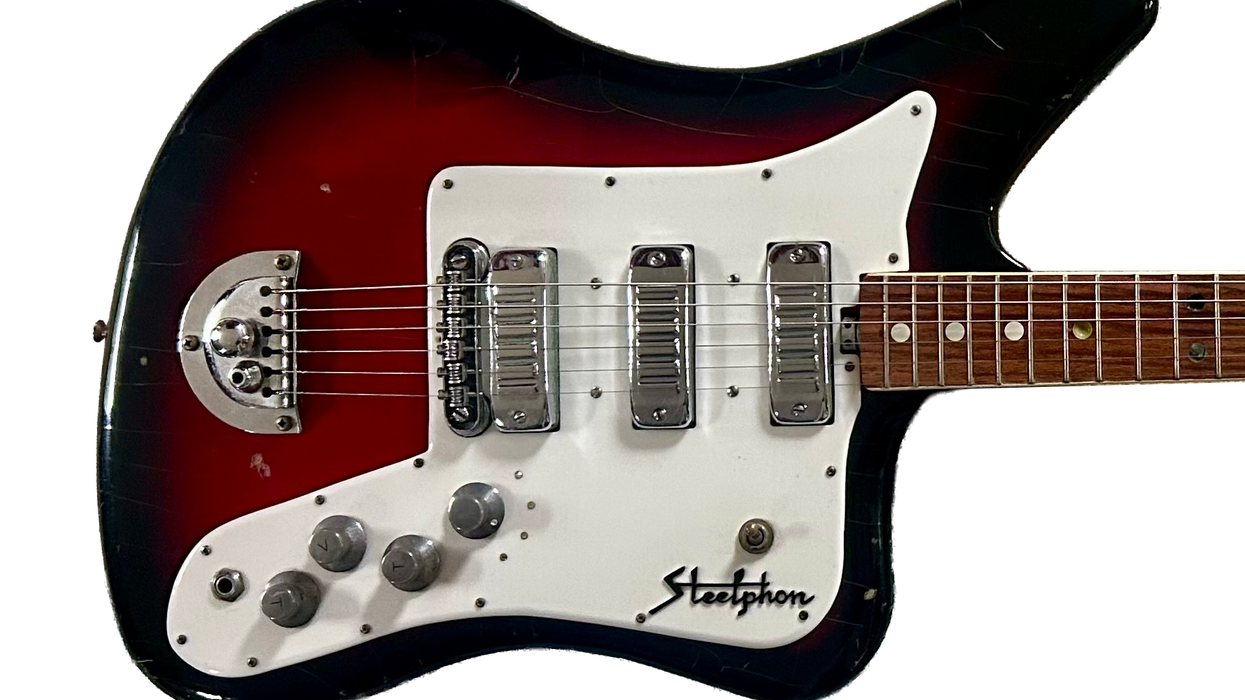
Last night something happened to me—I had a dream within a dream! Inception style! Here’s how it went down: I was dreaming that I had to unload a bunch of guitars from my car, and I was worried because I thought it was too hot outside and the guitars would get damaged. But when I went outside, there was snow everywhere! I wandered through the piles of snow and found my car buried. I remember looking down and I was walking on clear ice, and I could see little fish swimming around under there. I finally got into my car and I was freezing, but I still checked out the guitars to see if everything is cool. Suddenly, the ice started to melt extremely fast, and before long, I was floating in water! Right then, I started thinking about this one particular guitar because I thought it would make a good paddle.
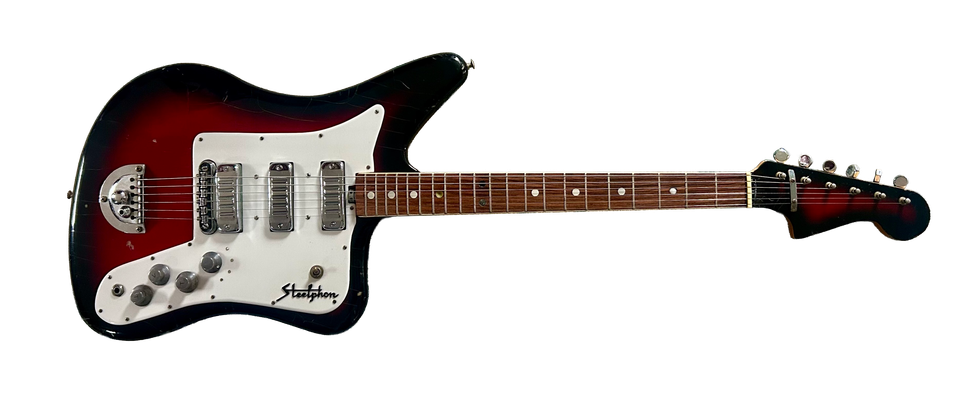 Then, in the dream, I “awoke” and realized I was back in my bedroom, and it was all just a dream. The kicker is that I was still dreaming, because that “paddle” guitar was suddenly in my hands—then I woke up for real! How about that misadventure?
Then, in the dream, I “awoke” and realized I was back in my bedroom, and it was all just a dream. The kicker is that I was still dreaming, because that “paddle” guitar was suddenly in my hands—then I woke up for real! How about that misadventure?
The next day (in real life), I went down to the basement to find this weird old bugger that, in my dream, would’ve made a good paddle. Apparently, this pancake-batter-shaped Steelphon is one of only a few known to exist, and I had forgotten that I still had it! Hailing from the mid ’60s, this Italian-made electric is a true oddity. Steelphon, which is an odd name in and of itself, was a company based in Turin, Italy, that was already making guitar-related items, primarily amps, but of course jumped into electric guitars during the boom years. The company seemed to contract out guitar production, because this one has all the characteristics of a Crucianelli-made guitar: the robust truss rod, the mini humbuckers, and the amazing bridge (which is like a steel brick) that would put any Gibson bridge to shame.
The amazing mini humbuckers are hot as hell and sound phenomenal—probably my all-time favorite pickups. The electronics feature a preset tone selector, pickup selector knob, and volume and tone knobbies. Playability is obviously weird because the body is so darn wide, and a little heavy. Plus, the neck is slightly thin so the whole experience is a little wonky. But again, the guitar sounds so good that it could be worth it for those looking for the “odd” factor.
“This pancake-batter-shaped Steelphon is one of only a few known to exist, and I had forgotten that I still had it!”
Back in the day, I coveted this guitar for a long time. There was a fellow in the Netherlands who collected and sold the strangest guitars, and this was on his site forever. Eventually, I ended up buying this and a few others from him, but when I got this guitar, it was a basket case. Playability was awful, the electronics were a mess, and the fret dots seemed to have been repaired by a kindergartener. The Steelphon also suffered from the dreaded Italian finish-shrinkage, which caused the guitar to have a lot of finish checking and splitting, kind of like a candy-coated finish that got cracked.
All in all, we were able to sort everything out, and now the guitar plays rather well. A hallmark of many guitars from the ’60s is that the electronics were overly complicated. Designers back in the day were trying to get a lot of preset tonal options, but the overall sound was always getting muddied. Once you dive in under the pickguard, it’s always best to wire point-to-point to get the best sounding guitar—especially with these pickups, which are just so aggressive. They sound dreamy!
Get up to 60% off guitars, amps and pedals in Reverb’s Fall Into Gear sale

As the falling leaves mark the start of autumn, Reverb is celebrating the changing of the seasons with a mega sale. With up to 60% off across guitars, pedals and amps, the Fall Into Gear sale could be the perfect chance to cop a bargain.
Reverb has sliced the prices on plenty of top brands, from Fender to Gibson. Squier in particular has a slew of mighty fine axes up for grabs, with a Limited Edition Paranormal Offset Telecaster SJ going for just £210.60. The Olympic White electric, complete with a laurel fingerboard and tortoiseshell pickguard, is 36% off and it’s in mint condition.
If you’re keen for a more vibrant Squier, there’s also a Shell Pink Sonic Mustang available. The sale has knocked 45% off the price, dropping it down to a very respectable £121.19. And who can argue with that classy pastel sheen?
In terms of stompboxes, the M173 MXR Classic 108 Fuzz pedal is currently 53% off. Now just £75.15, the MXR’s new pricepoint is befitting of its ‘70s crunch, perfect for the fuzz-loving garage rockers of the world. There’s also a mint Carl Martin PlexiTone Single Channel Distortion pedal available for £93.75. The simple-yet-effective stomper comes in its original packaging, ripe and ready to add some edgy distortion to your sound.
Elsewhere, a rare Marshall mixing desk is also included in the many sale offerings. Made in England back in 1978, the 8 Channel Marshall Mixer boasts 100 watts of power. It is also fitted with legit spring reverb, and can even go into overdrive – essentially offering the power of 8 head amps. It’s still in good nick, and it’s available for 20% off, costing £639.20.
Head over to Reverb to find more Fall Into Gear Sales Event deals. The sale runs until 3 November.
[deals ids=”XP79QIUJCCOqy0k0cAnSM”]
The post Get up to 60% off guitars, amps and pedals in Reverb’s Fall Into Gear sale appeared first on Guitar.com | All Things Guitar.
Paul McCartney reflects on legendary Japan drugs bust that landed him in prison: “This stuff was too good to flush down the toilet!”

While the matching bowl haircuts and boy-next-door charms might fool you, The Beatles were prone to their fair share of rock ‘n’ roll debauchery – need we mention 1967’s LSD-inspired Sgt. Pepper’s Lonely Hearts Club Band? In fact, Paul McCartney very nearly earned himself a seven-year prison sentence back in 1980 for smuggling marijuana into Japan.
McCartney opens up about his prison scare in his new book, Wings: the Story of a Band on the Run. As he puts it, the weed was “excellent”, so it was worth the risk. “I was out in New York and I had all this really good grass,” the Beatles legend recalls [via The Sunday Times]. “We were about to fly to Japan, and I knew I wouldn’t be able to get anything to smoke over there. This stuff was too good to flush down the toilet.”
Having just been in America, where President Carter was considering decriminalising cannabis, McCartney thought marijuana was “no big deal”. He’d also done plenty of ‘harder’ drugs in the past, notably “seeing God” on Dimethyltryptamine (DMT) during The Beatles’ heyday. The response from the Tokyo airport officials was a massive culture shock.
“It was the maddest thing [I’d done] in my life – to go into Japan, which has a seven-year hard-labour penalty for pot, and be so free and easy,” he recalls in horror. “I put a bloody great bag of the stuff right on the top of my suitcase. Why didn’t I even hide it in a pullover?”
McCartney’s daughters Stella and Mary were also present at the drugs bust. Mary chimes in with her own memory of the event: “I just remember them saying to Mum and Dad, ‘Whose is this?’… [then they looked] at each other, going, ‘Which one of us is going to do this? Because one of us needs to stay with the kids.’ Dad said it was him, and then they took him away.”
Though, Stella adds that “even a nine-year-old could have hidden skunk weed better” than her father had.
 A customs officer inspects one of the plastic one of the plastic bags containing marijuana which hidden inside one of Paul McCartney’s luggages after he was arrested for illegal possession of marijuana at New Tokyo International Airport in Narita 1/16. Credit: Getty Images
A customs officer inspects one of the plastic one of the plastic bags containing marijuana which hidden inside one of Paul McCartney’s luggages after he was arrested for illegal possession of marijuana at New Tokyo International Airport in Narita 1/16. Credit: Getty Images
The very same evening, McCartney confessed and was arrested for drug possession. “I apologised for breaking Japanese law,” he says. “It probably didn’t help that I had more than I could get through in a month… I had to go through my whole life story – which schools I went to, my father’s name, our address, my income. I even had to tell them about my MBE medal from the Queen.”
In the West, rockstars tend to be pretty open about their drug habits. Tony Iommi has gone on record admitting that Black Sabbath had a dealer show up “every day” during the recording on 1972’s Vol. 4, and The Rolling Stones were also prone to the odd acid trip. But, as McCartney puts it, the Japanese response was incredibly serious.
The musician had been travelling to perform in Japan with his band Wings. Overnight, every single tour poster was torn down. “Every hundred feet there had been a poster saying, ‘Wings – the greatest rock band in the world visits Japan 1980,’” Wings drummer Steve Holley notes. “They were everywhere… it was inestimable how many there were. And in the morning, they were all gone. The radio stations went silent, too. They wouldn’t play anything.”
Considering the severity, McCartney even thought his family would have to live in Japan to still see him behind bars. But he tried to remain positive. “I couldn’t sleep for the first three days…” he continues. “I had to share a bath with a bloke who was in for murder. I was afraid to take my suit off in case I got raped. But I’d seen all those prisoner-of-war movies and I knew you had to keep your spirits up.”
In order to “keep spirits up” McCartney did what he does best – he performed. “I’d organise singsongs with the other prisoners,” he admits. “There were guys in the next cell and we tried to communicate. I was trying to learn a few words in Japanese, and I could hear people saying konnichiwa (hello). So I turned that into “Connie Chua”. Like a high-school girl, Connie Chua. I could say arigato, thank you, but I couldn’t say much more.”
Despite only being in the prison for nine days, McCartney would write the book Japanese Jailbird reflecting on his experience. And, even though it was a stressful experience, prison guard Yasuji Ariga noted that McCartney remained “very polite and made a good impression on the guards”.
“I was happy to leave [after nine days], but I’d made a couple of friends in there so the parting was a little sad,” McCartney admits. “As I walked free, I was shaking hands with these prisoners through the letterboxes of their cells.”
However, the arrest didn’t seem to sour McCartney’s taste for marijuana. Following on from the arrest, McCartney would call for cannabis to be legalised four years later in 1984. Speaking to press outside of a London Airport, he said: “I don’t believe [smoking cannabis] is a terribly harmful thing to do… cannabis is a whole lot less harmful than rum, whiskey, nicotine or glue – all of which are perfectly legal. I’d like to see it decriminalised, because I don’t think, in the privacy of my own room, I was doing anyone any harm whatsoever.”
McCartney’s new book, Wings: the Story of a Band on the Run, is out 4 November. McCartney will also be releasing a definitive collection of Wings tracks on 7 November.
The post Paul McCartney reflects on legendary Japan drugs bust that landed him in prison: “This stuff was too good to flush down the toilet!” appeared first on Guitar.com | All Things Guitar.
The 14 best amplifiers for all styles and budgets
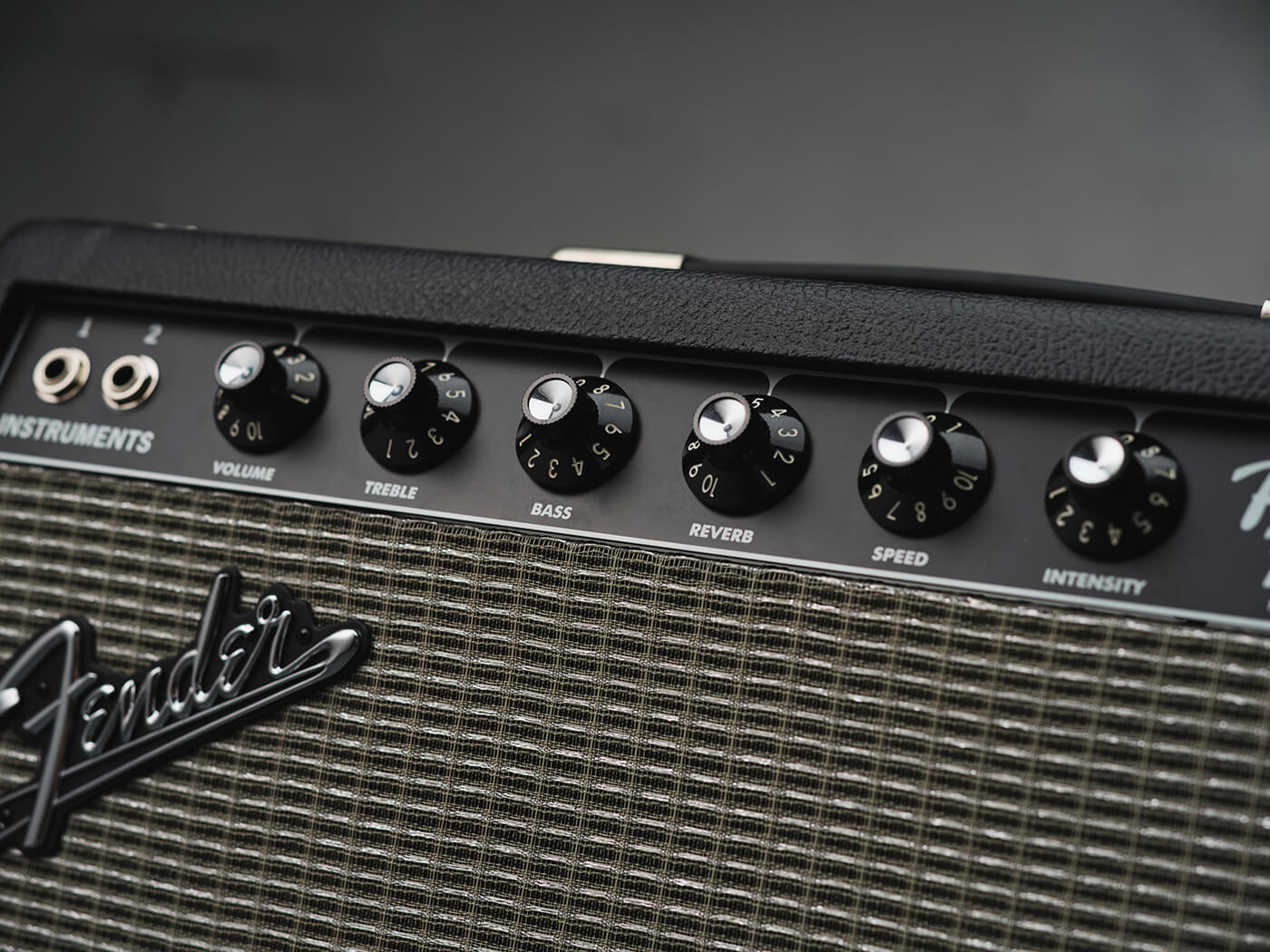
The world of amplifiers in 2024 is a wonderfully wide-ranging one, with tube amps, digital amps, floor amps, portable amps, practice amps desktop amps and more all promising brilliant tones at varying levels of volume. A little intimidated by the choice? Not to worry – we’ve put together this guide to the best amps no matter what you need, whether that’s a small home amp or a gigging powerhouse.
Digital amps continue to make excellent use of ever more powerful processing – from high-quality modelling units with endless amp sims and ins and outs, to stripped-back combos leveraging digital power for efficiency and reliability, digital amps have come leaps and bounds since those early days of fizzy direct sounds and tinny practice amps. And, of course, tube amp makers continue to find ways to make those classic circuits even more appealing to the modern player. There are plenty of excellent options out there, no matter what you want out of an amplifier. Let’s dive in.
The 14 best amplifiers, at a glance:
- Our pick: Fender Tone Master Princeton Reverb
- Best solid state amp head: Orange Tour Baby 100
- Best affordable amp: Boss Katana 50 MkII EX
- Best tube amp: Bad Cat Hot Cat 1×12
- Best modelling amp: Fender Mustang GTX100
- Best desktop amp: Yamaha THR30II
- Best high-end amp: Marshall ST20H JTM Studio
- Best home amp: Positive Grid Spark Mini
- Best gigging amp: Fender Hot Rod Deluxe IV
- Best combo amp: Blackstar St. James 50 EL34
- Best amp head: Orange OR30
- Best amp pedal: Neural DSP Quad Cortex
- Best busking amp: Positive Grid Spark Live
- Best beginner’s amp: Blackstar Debut 50R
- Best metal amp: Victory The Kraken MKII
- Why you can trust Guitar.com
[products ids=”oBpEGJtH0WdblZ47yVk6i,2VTvjx57xipCjpM29Uk4IK,BhUbWgU9DQr7bgrzcM09P,uhwV5J8pOdyQTSonzyJHp,7je5eH2spPriM7n13bIuAz,4VR8cF781XsL4wm33IEzQs,5ph5QMKZhJCIbrn40QuGrh,zepk4RqunCbSIFN0Q1K3A,4WfInLLZeZnNZFpJRmVPHG,6S6w6uKrRj9aM58IBkXAUx,4cDpuBQfkUhwXUrrSLYElh,56O4XNZQn8feYt4u8LcT3p,4eIZyJgJOkfDfe5xy46y6T,72MogFZ0vwHKMXhIUN1okP”]
Our pick: Fender Tone Master Princeton Reverb
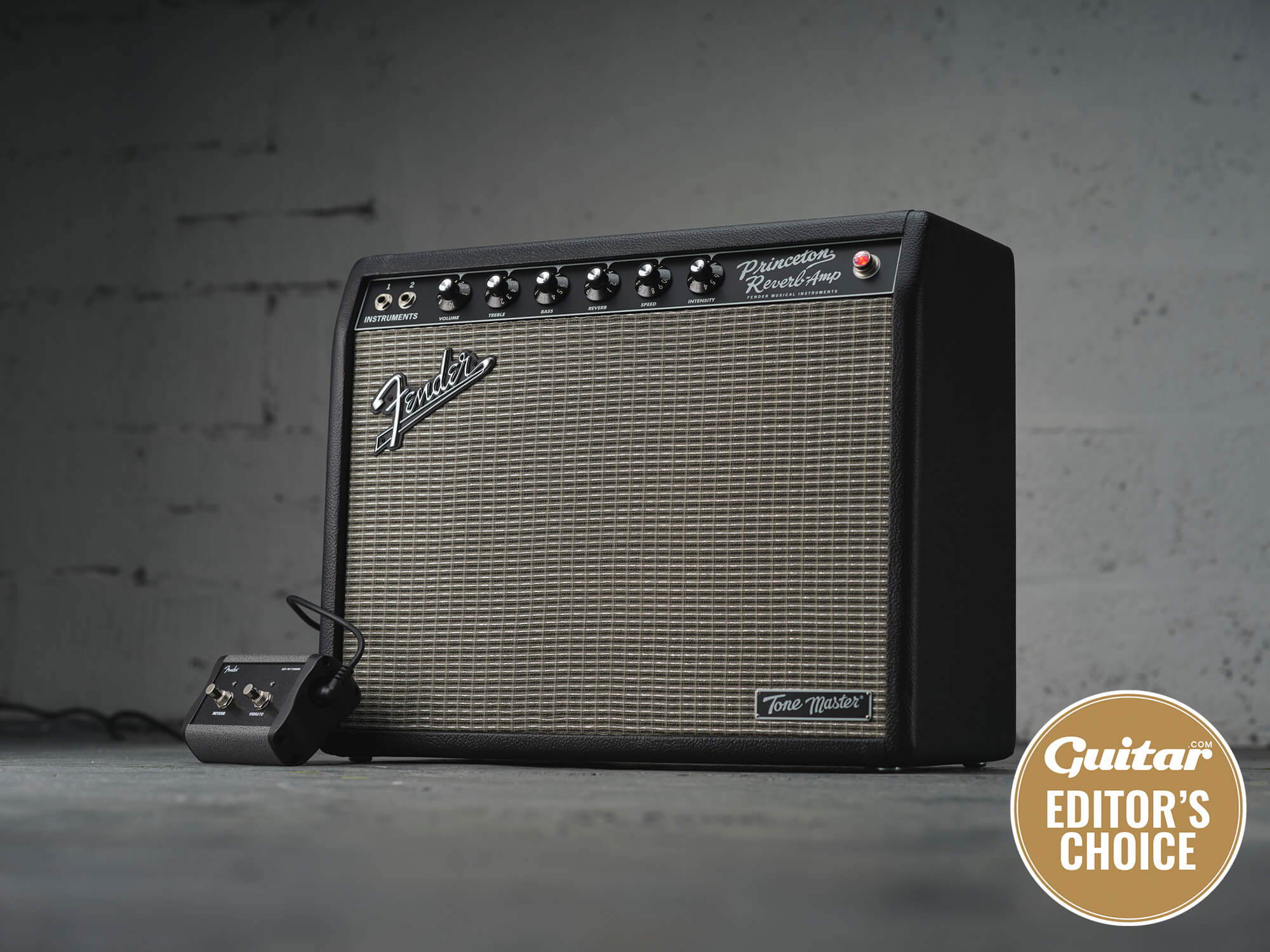
[products ids=”oBpEGJtH0WdblZ47yVk6i”]
Fender’s Tone Master amplifiers are pitched as modelling amps for those who hate modelling amps: no menus, no deep-editing, no complex multi-mode preamp selection. Instead, the modelling power is aimed squarely at a single amp – in this case, the Princeton Reverb. The result is a combo that sounds and looks basically indistinguishable from the real thing. Aside from that Tone Master badge, the best way to tell them apart is to pick them up, as this one’s literally half the weight of its bottle-fed counterpart.
The sounds are all there, and you can play it at home just as easily as you can on a stage. The power-reduction modes give you a consistent sound across all ends of the volume spectrum, and of course, achieve the awesome sound of a Fender combo breaking up without breaking any windows… or your relationship with your neighbours.
Need more? Read our Fender Tone Master Princeton Reverb review.
Best solid-state amp head: Orange Tour Baby 100
 Image: Press
Image: Press
[products ids=”1Wm3RZH94Qmcv7woe2mJ3D”]
Digital modelling amps are all well and good, but analogue solid-state amps also have their advantages! And there’s perhaps no better example of that than Orange’s Tour Baby 100. It’s simultaneously a 100-watt powerhouse and a compact one-hand lift – while delivering a great sound thanks to its growling overdrive channel and sparkly clean channel. That built-in compressor helps you fast-track to a more interesting clean sound, too. And thanks to Orange’s general design ethos, it’s got a very versatile midrange-forward sound, great for many shades of rock and metal, and comes with a tour-ready gigbag for even more portability. Don’t trust anything less than bulletproof protection? Grab a rack-mount kit for it for even more ruggedness. It’s also pretty affordable at a hair under £500.
Need more? Read our Orange Tour Baby 100 review.
Best affordable amp: Boss Katana 50 MkII EX
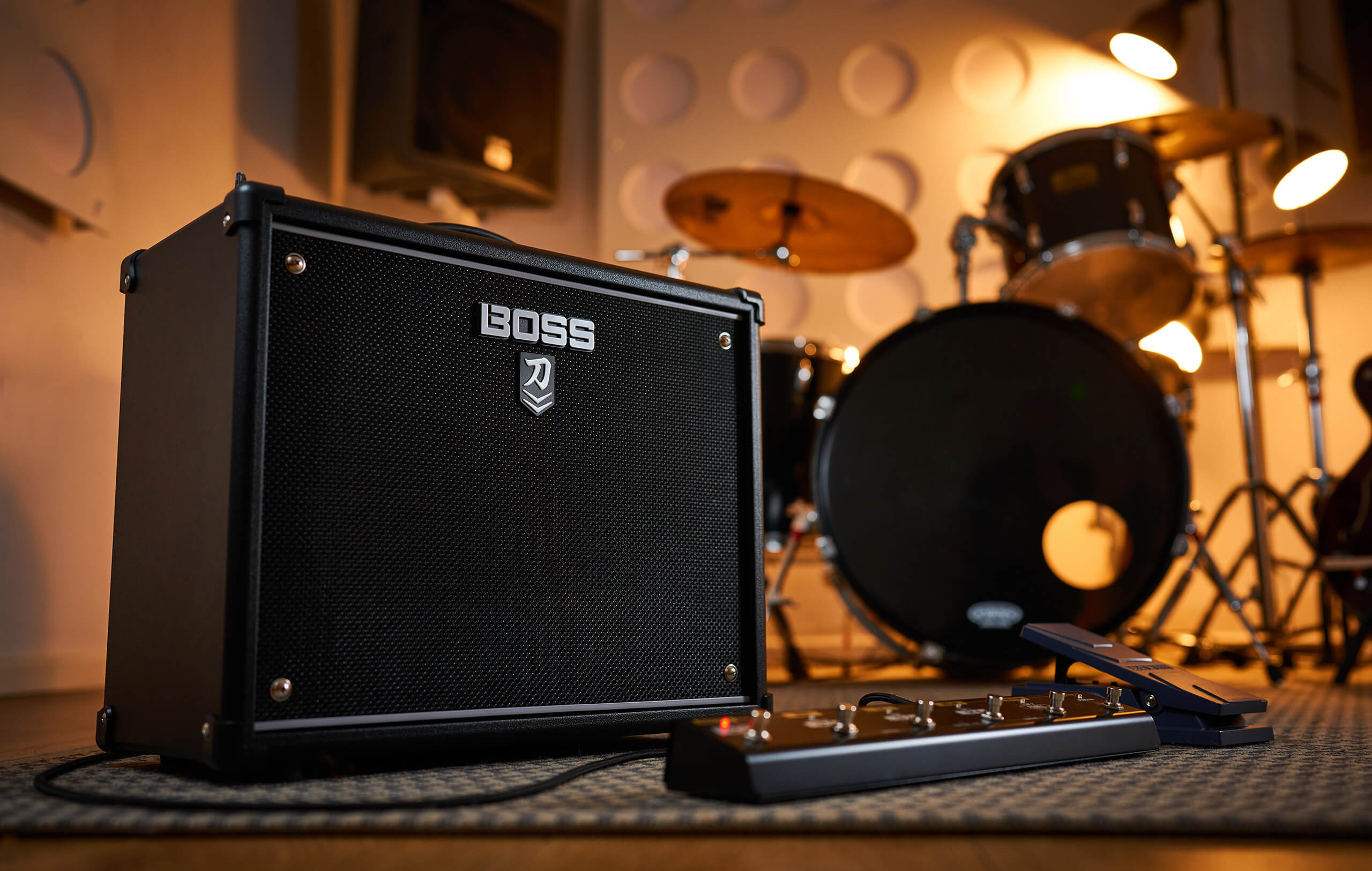
[products ids=”2VTvjx57xipCjpM29Uk4IK”]
While the Tone Master Princeton Reverb is a very appealing prospect indeed, it’s still a relatively pricey amplifier. The Katana 50 MkII EX, however, is a good deal more affordable, and is just as happy on a stage as the Tone Master – but it can also provide excellent at-home practice sounds, through headphones, or its 12-inch speaker thanks to its power reduction switch. There’s a good range of sounds on tap here, with perfect cleans, chimey overdrive and full-bore metal all represented, plus a suite of effects thrown in, too. The EX version of the amp adds some extra footswitch control options, too – making going without a pedalboard a lot easier.
Need more? Read our Boss Katana 50 MkII EX review.
Best tube amp: Bad Cat Hot Cat 1×12
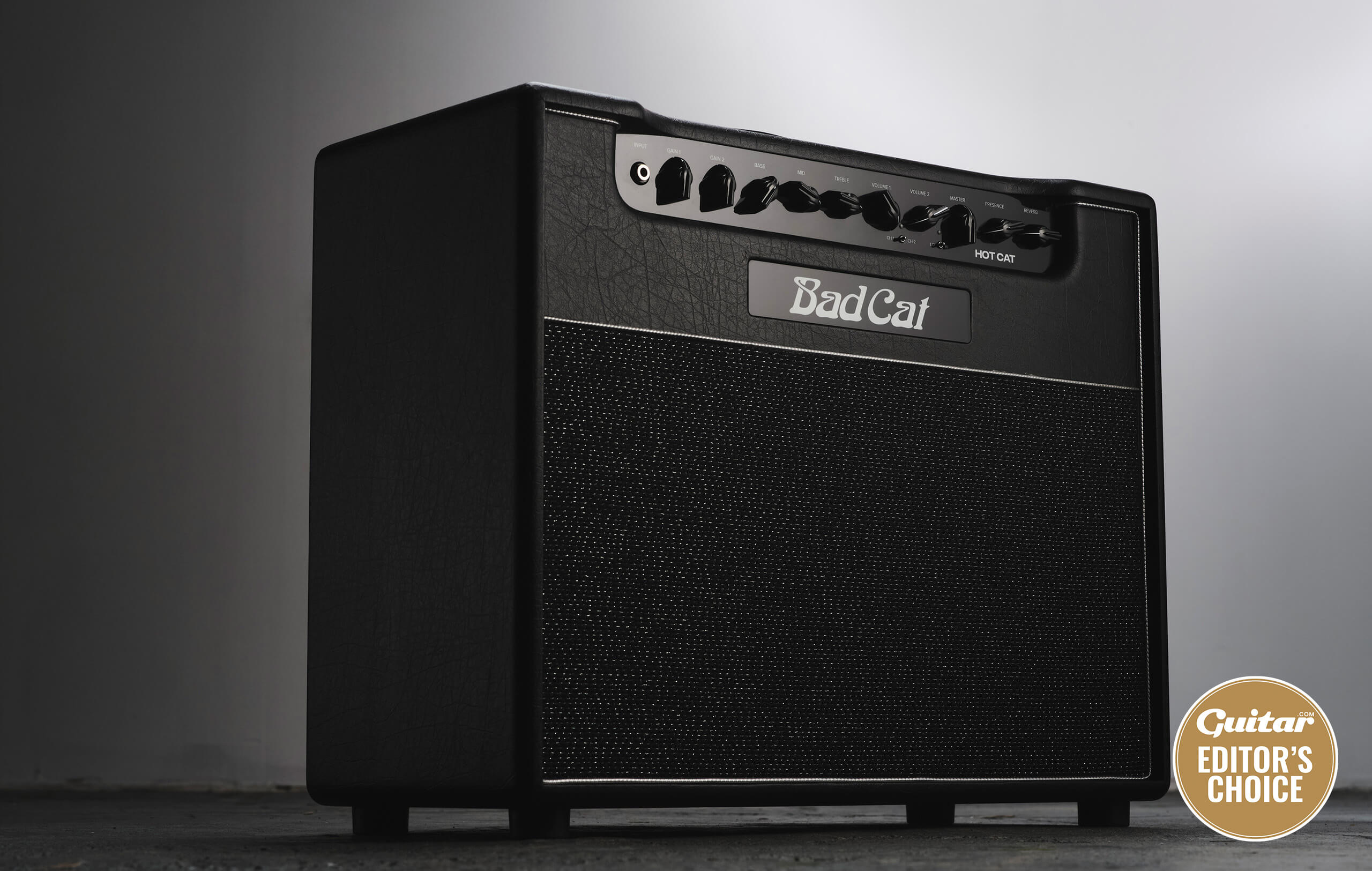
[products ids=”BhUbWgU9DQr7bgrzcM09P”]
Californian boutique brand Bad Cat has gone through, if not quite nine lives then several different iterations, but the current iteration was reborn in 2021 and overhauled the entire line of amps that had made the brand so sought-after in the first two decades of the 2000s. The Hot Cat is something of a statement of intent for the new Bad Cat – it might not be a hand-wired, super-high-end beast any more but it’s a classy combo for big cleans, edgy crunch and high-gain punishment, without you needing to remortgage your house. Arguably the most affordable way to get a slice of bona fide US-made boutique amp in 2023.
Need more? Read our Bad Cat Hot Cat 1×12 review.
Best modelling amp: Fender Mustang GTX100
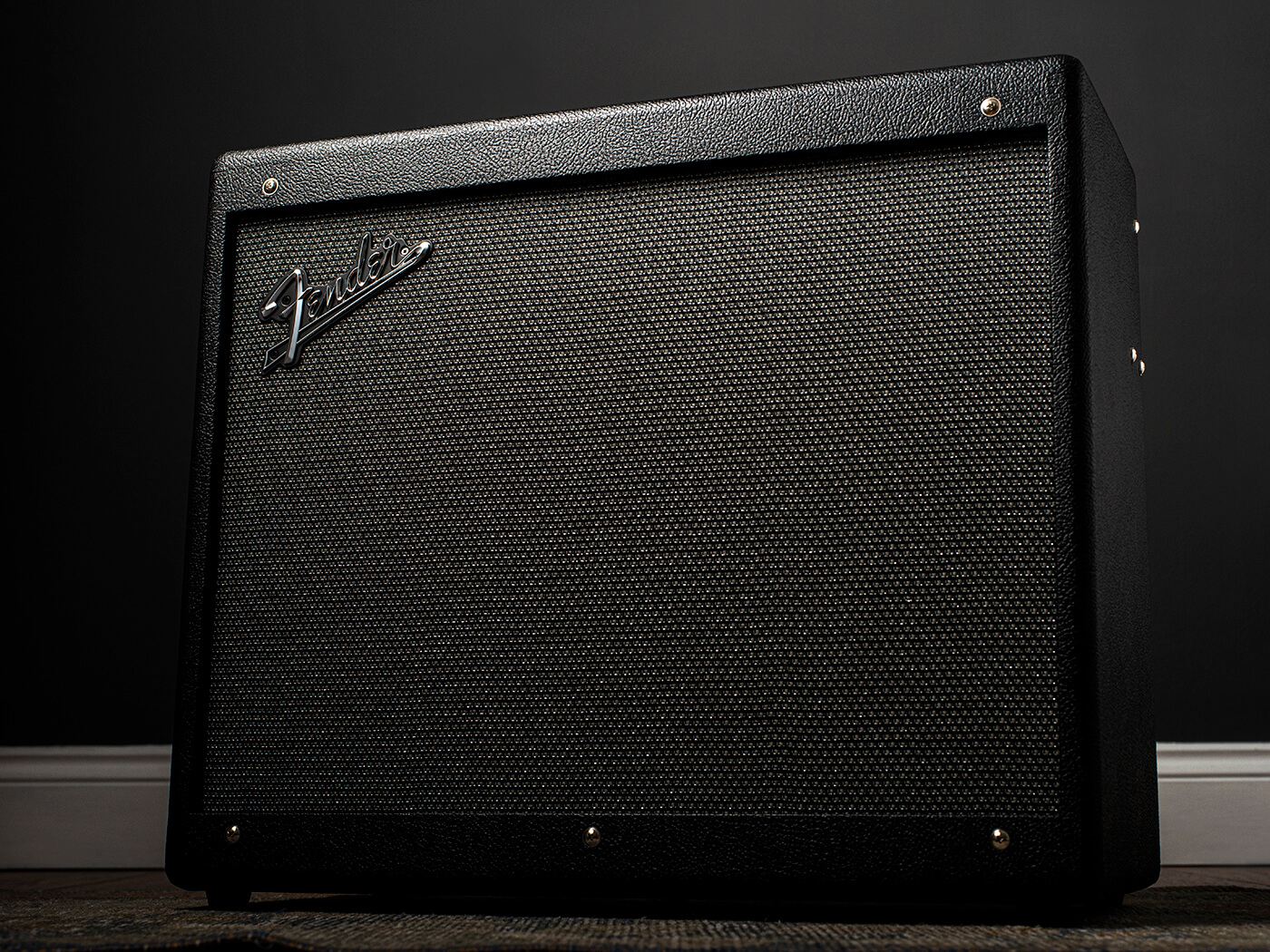
[products ids=”uhwV5J8pOdyQTSonzyJHp”]
Loaded with a hefty 100 watts and a new custom-designed 12-inch Celestion speaker, the Mustang GTX100 is a very serious entry from Fender into the world of digital modelling combos. Unlike the Tone Master amps’ laser-focus, the Mustang GTX100 comes loaded with 39 amp models and 73 effects, which might just be more than you’ll ever need. It’s especially appealing as the GTX-7 foot controller is included in the price – this versatile bit of kit comes with a good number of footswitches, and makes using the GTX100 live without a pedalboard a breeze.
Need more? Read our Fender Mustang GTX100 review.
Best desktop amp: Yamaha THR30II
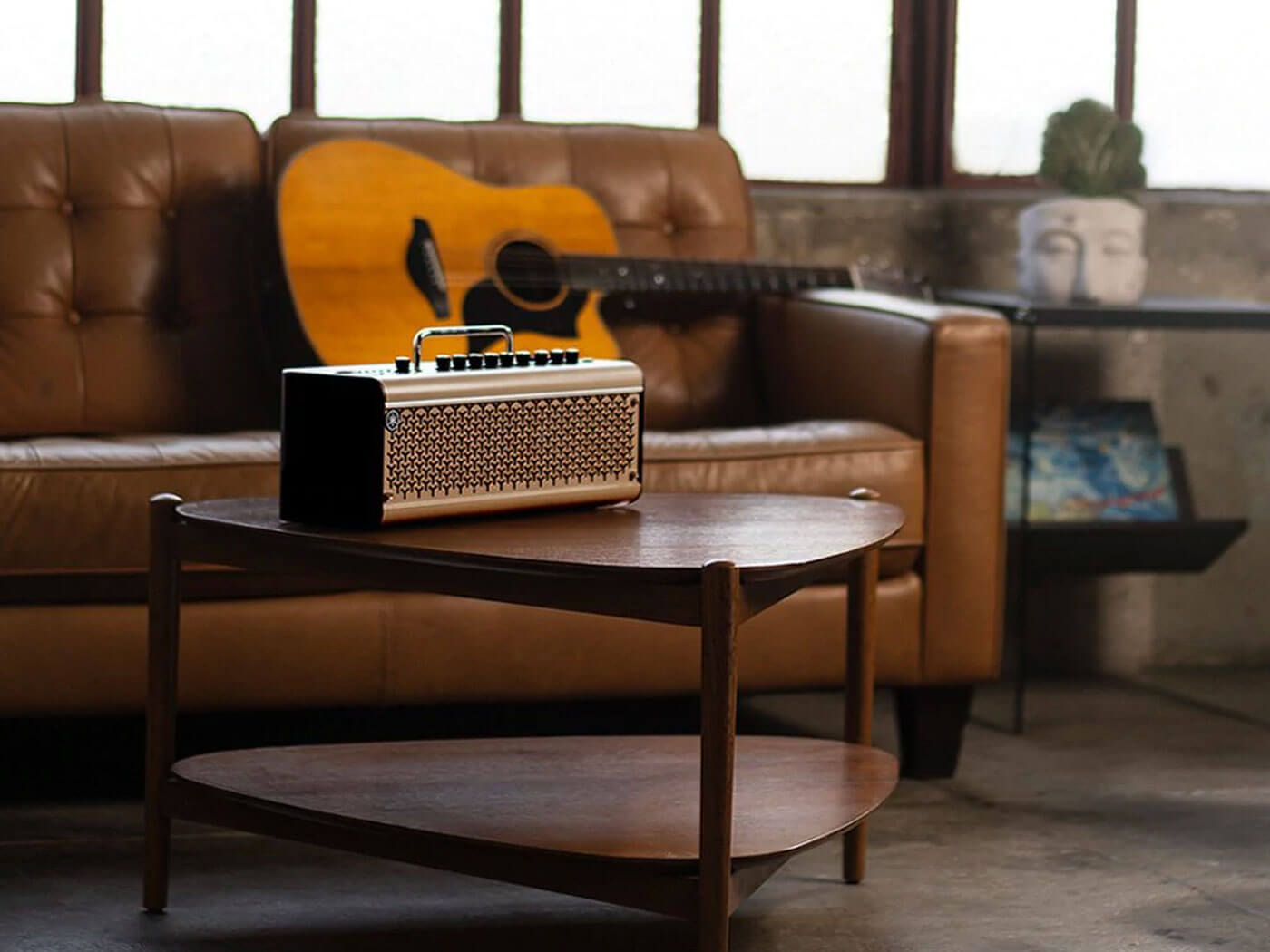 Image: Yamaha
Image: Yamaha
[products ids=”7je5eH2spPriM7n13bIuAz”]
Arguably, the THR is the line of amps that invented this whole product category in the first place. There’s a good range of sounds, with 15 preamp models in total and effects ranging from subtle chorus to big reverbs. But this is all somewhat par for the course in 2024 – what gives the THR30II its edge are these two things: first, it looks like a cool retro radio and therefore can absolutely live on your coffee table without you having to plonk a big piece of obvious guitar equipment in the middle of your living room. Secondly, there’s a great range of I/O on offer, including direct USB recording and two quarter-inch line-outs.
Combine these two things with the sheer quality of the sounds, the THR30II nails what Yamaha has set out to do with the “third amp” approach. All of the sound and versatility of a “real” amp, none of the sacrifices of a practice amplifier. There’s also an acoustic version of the THR-30II, the THR-30IIA, which offers the voices of various microphones in lieu of a range of electric preamp modes, but just as much appealing good looks and versatile recording options.
Need more? Read our Yamaha THR30II review.
Best high-end amp: Marshall ST20H JTM Studio
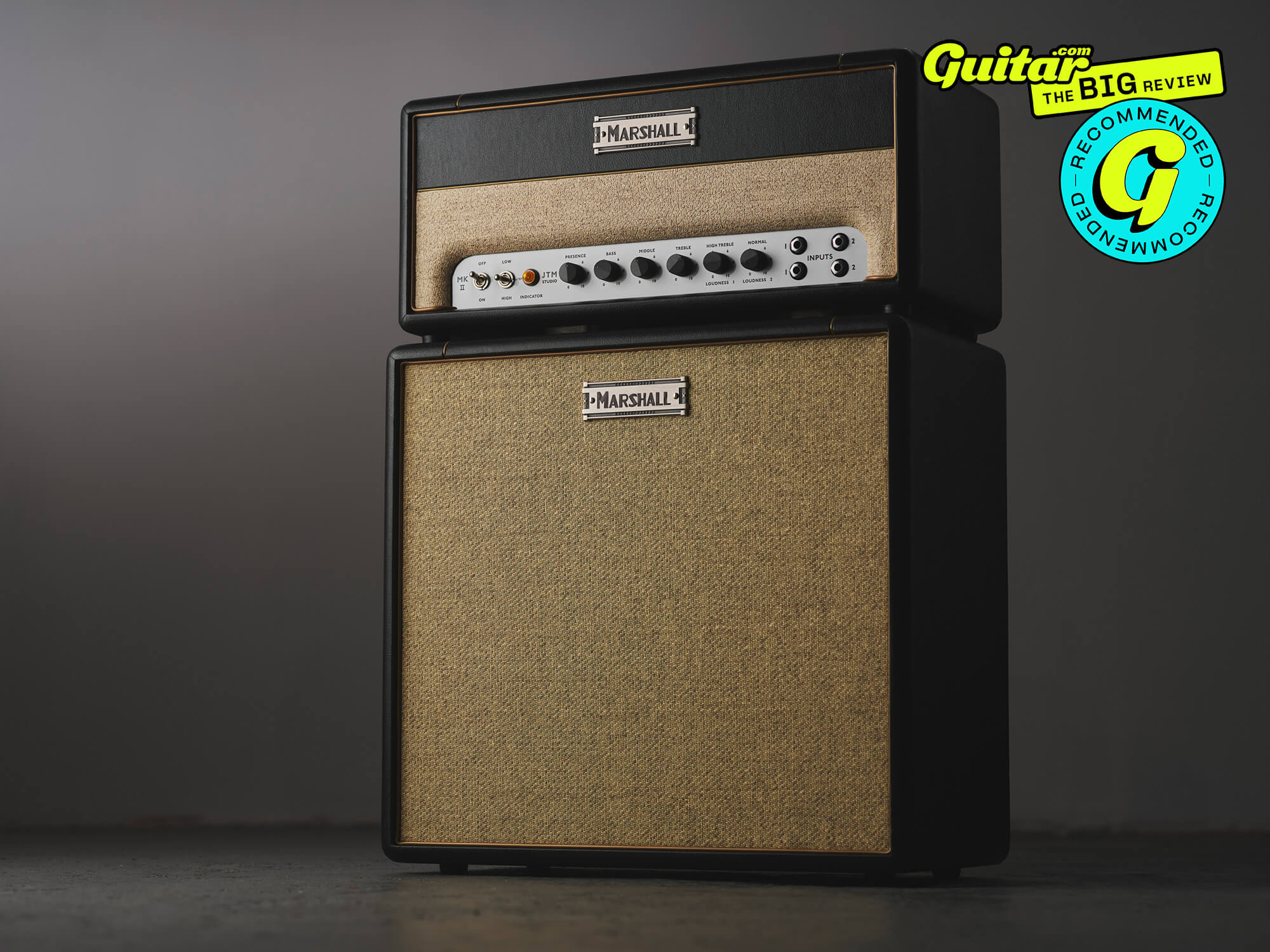 Marshall ST20H JTM Studio. Image: Adam Gasson
Marshall ST20H JTM Studio. Image: Adam Gasson
[products ids=”4VR8cF781XsL4wm33IEzQs”]
It’s no exaggeration to say that the JTM is part of the very fabric of rock music – after its introduction in 1962, it would shape the landscape of rock and blues by offering massive sounds to an exploding UK rock scene. This UK-made revamp of the JTM harkens back to the very earliest Marshall amps with that fawn cloth and ‘coffin’ Marshall badge. Sonically, the ST20H JTM Studio recreates all of the nuance of the original’s punchy, snarling take on a modified Fender bassman circuit, but there are some concessions to modernity, too. An effects loop and a power-reduction mode make this a very appealing prospect for the modern player indeed.
Need more? Read our Marshall ST20H JTM Studio review.
Best home amp: Positive Grid Spark Mini
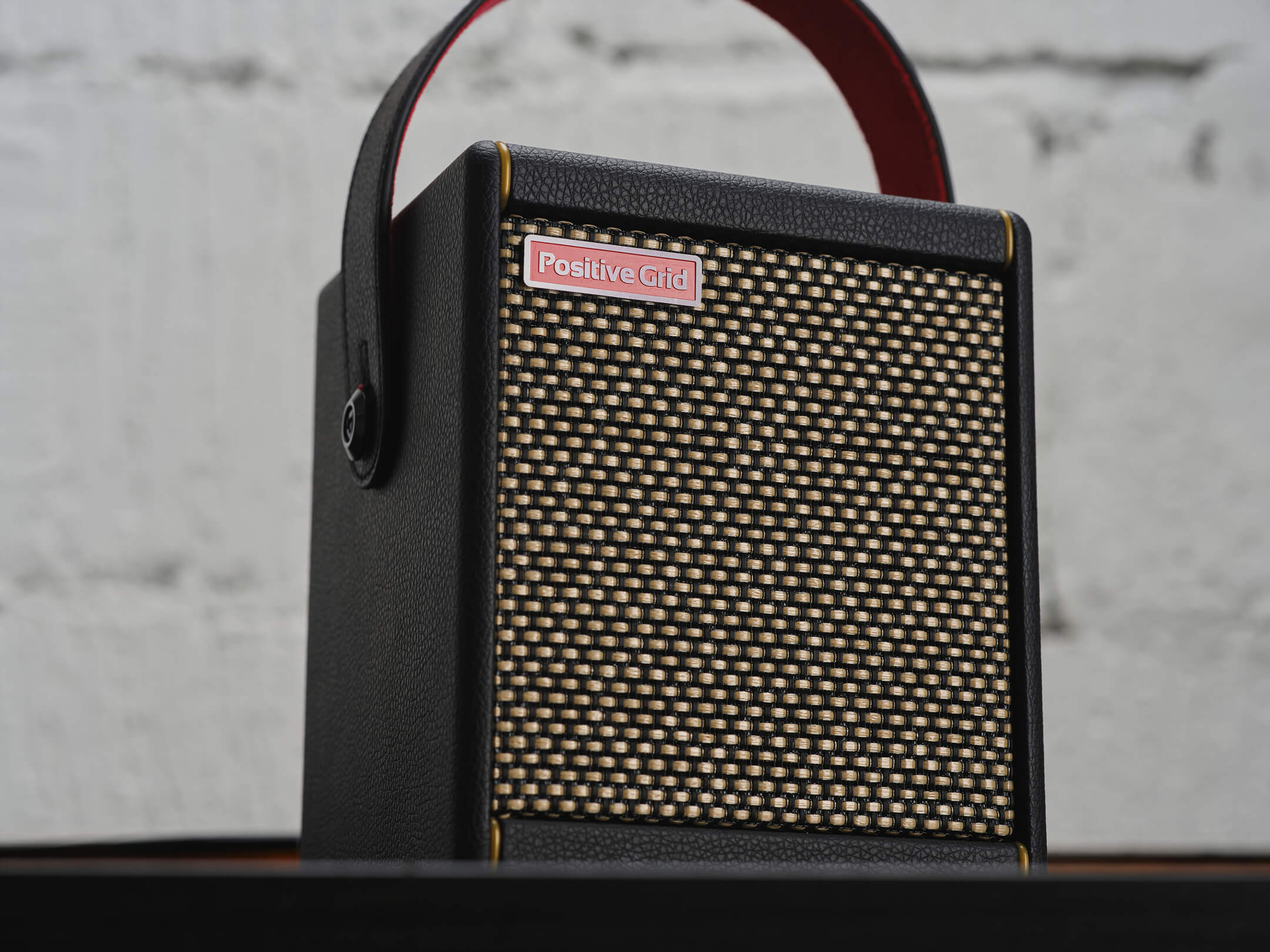 Image: Adam Gasson
Image: Adam Gasson
[products ids=”5ph5QMKZhJCIbrn40QuGrh”]
The Spark Mini, Positive Grid’s adorable cube-shaped cousin of the full-sized Spark, is a massive acheivement in compact amplifier design. Because it doesn’t just sound good for a small practice amp. Nor does it just sound good for a modelling amp – it’s just a great sounding amp. Full stop. No qualifications. The passive radiator on the bottom of the amp – a similar thing to what you’ll find on a good modern bluetooth speaker – helps the pair of two-inch speakers create a lot more bass than would normally be possible. Combine this with quality modelling and an actually useful and intuitive companion app (it’s possible!), and you’ve got basically the perfect small amp for learning and playing around on at home.
Need more? Read our Positive Grid Spark Mini review.
Best gigging amp: Fender Hot Rod Deluxe IV
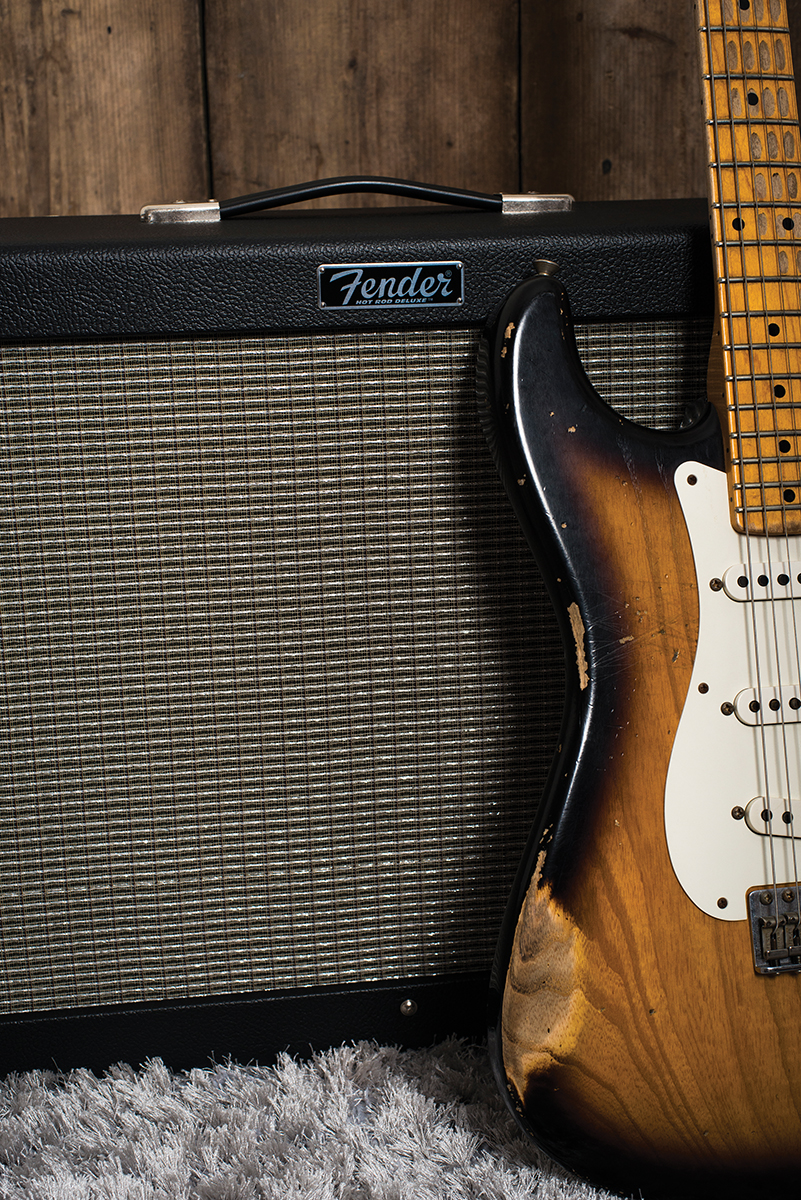
[products ids=”zepk4RqunCbSIFN0Q1K3A”]
If you know you’re going to be getting loud, then the Hot Rod Deluxe IV is an amazing option. It’s capable of moving more air than you could ever need, and its chewy tube overdrive sounds get even better if you bring some pedal friends along. If you need cleaner time-based effects, there’s an effects loop. Approachably priced, easily carriable from the boot of your car to the stage, reliable and versatile, there’s a reason the HRD is one of the most popular gigging workhorses around.
Need more? Read our Fender Hot Rod Deluxe IV review.
Best combo amp: Blackstar St. James 50 EL34
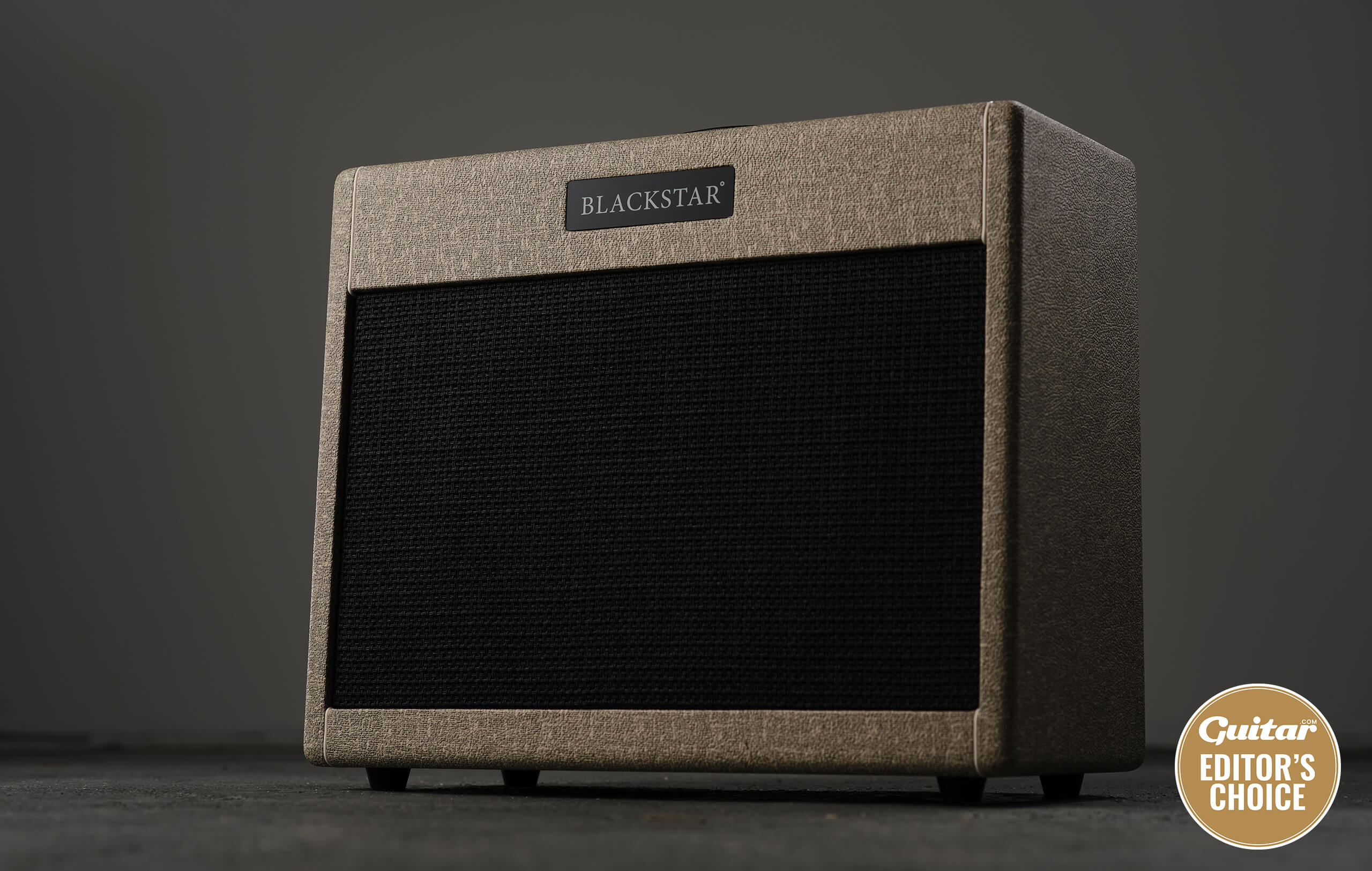
[products ids=”4WfInLLZeZnNZFpJRmVPHG”]
The pitch of the St. James series is this: a fully-fledged tube amp, but without the massive weight. A number of design changes to the regular tube amp format have been made, such as the use of a switching-mode power supply instead of a heavy transformer. The cabs and combos use a specially-made Celestion speaker with a lightweight frame and driver. The result is that the St James 50 EL34 is an easy one-hand lift – no mean feat for a fully-fledged 50-watt tube combo. That’d be all for naught if the sounds weren’t there, but luckily they are, with an excellent black-panel-style tonal palette that soaks up pedal tones amazingly. For an all-in-one combo package, it’s hard to argue with – and that’s not even mentioning the bevvy of smart features packed in, too!
Need more? Read our Blackstar St. James 50 EL34 review.
Best amp head: Orange OR30
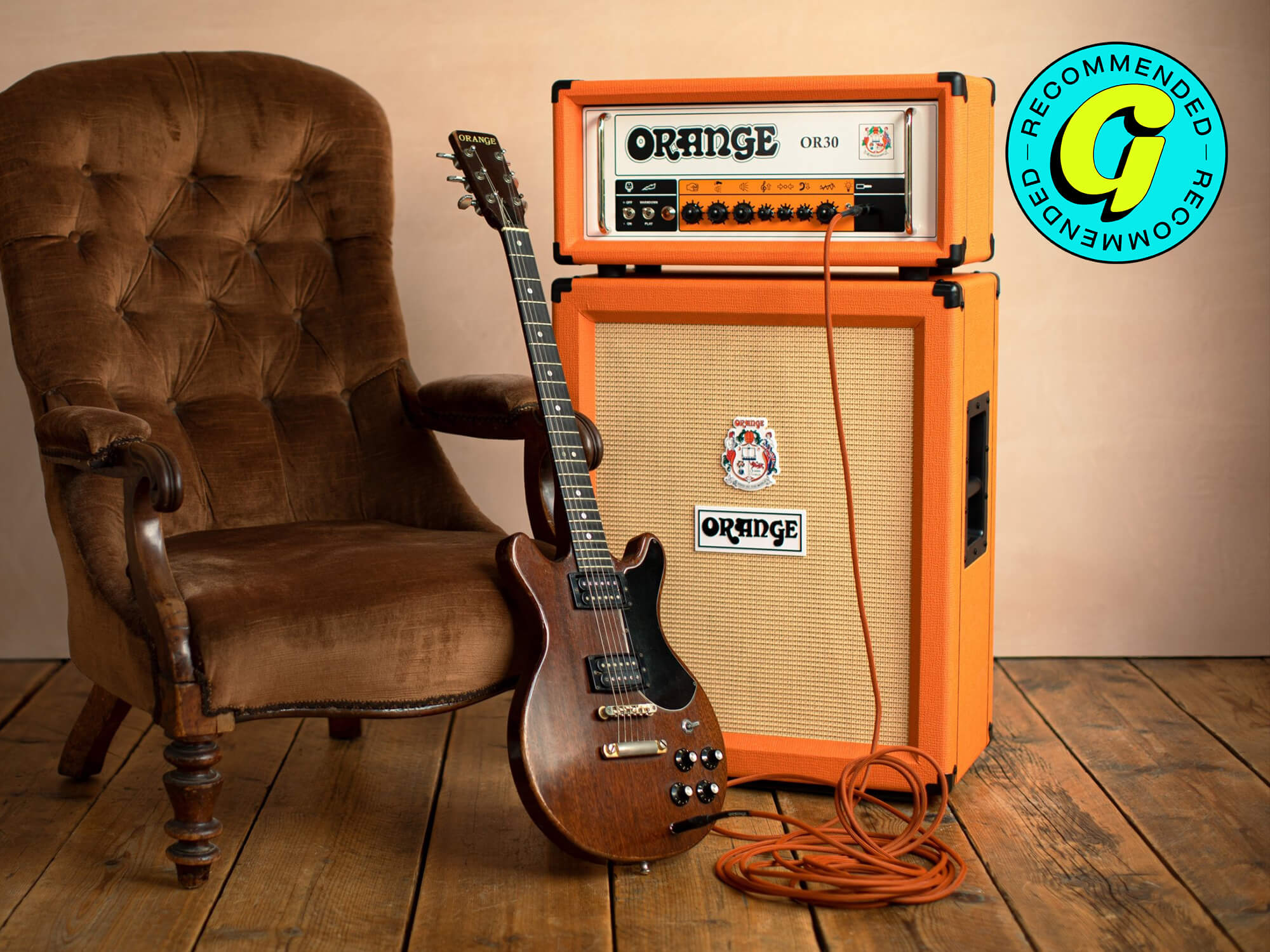 Orange OR30
Orange OR30
[products ids=”6S6w6uKrRj9aM58IBkXAUx”]
From a lightweight tube combo with lots of smart features to a decidedly not lightweight tube head with zero smart features. Yes, the Orange OR30 is a made-in-the-UK tube head that promises old-school simplicity with just one channel. But that’s not to say it’s not versatile – the gain control has a frankly absurdly wide sweep, with everything from pristine cleans to the massive, roaring fuzziness Orange has become known for represented.
Combine that with built-like-a-tank construction, an effects loop and a low-power mode, it’s a great option for the modern player, despite its old-school approach. Notably, it’s also one of the loudest 30-watters out there – Orange claims it can kick out SPLs to rival 100-watt heads!
Need more? Read our Orange OR30 review.
Best amp pedal: Neural DSP Quad Cortex
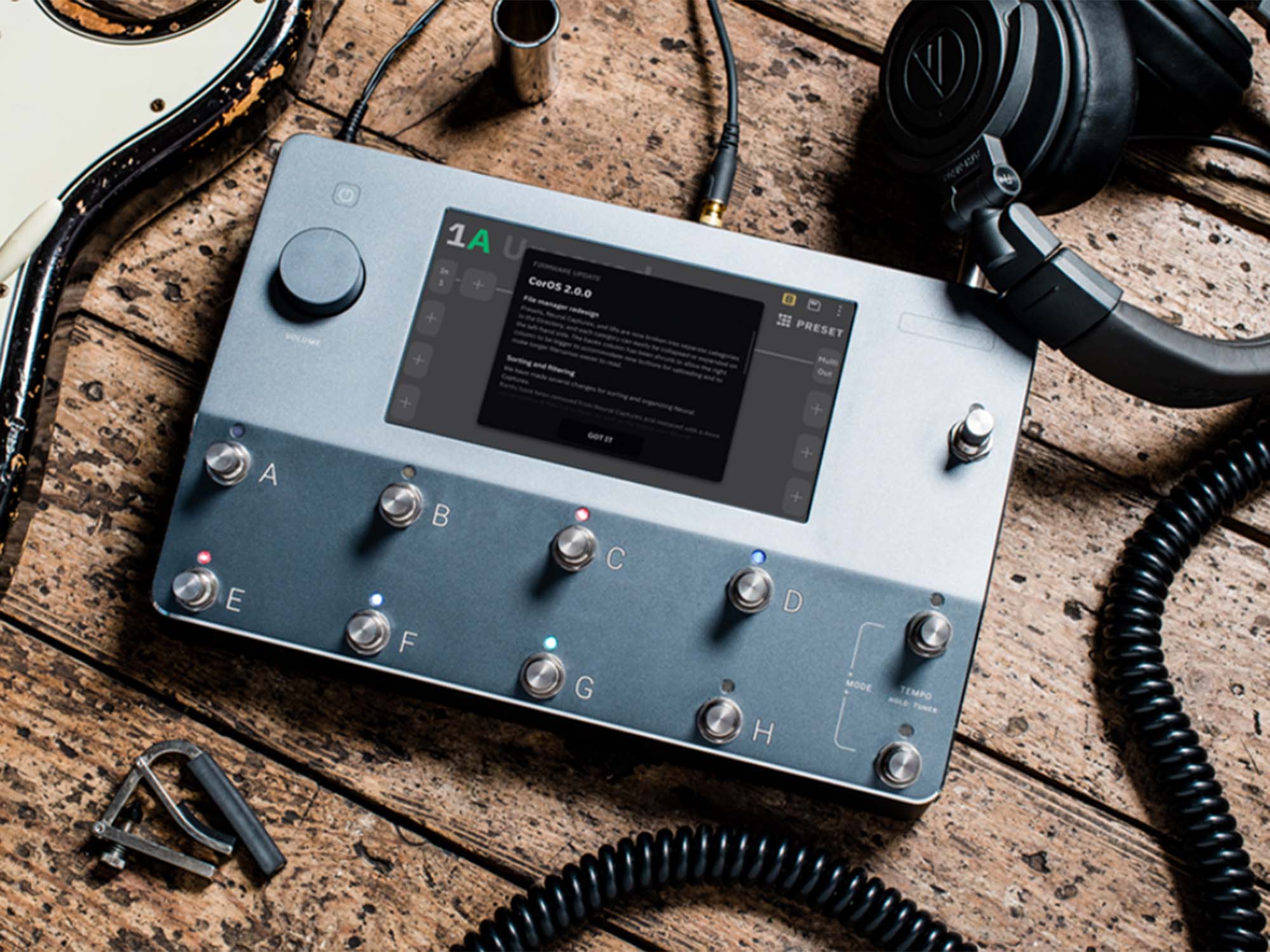 Image: Neural DSP
Image: Neural DSP
[products ids=”4cDpuBQfkUhwXUrrSLYElh”]
The world of amp-sim pedals is a wide and varied one, but for our money the Quad Cortex remains top of the heap when it comes to sheer modelling power and I/O capability. It might be magic, it might just be complex neural-net modelling – either way, the quality of the amplifier captures on offer here are astounding.
It’s not just their sonic fidelity – the models here also manage to capture that ever-elusive feel of real amplifiers. The unit itself is relatively compact, which, combined with its extensive I/O offerings, makes it a great option for gigging. You can replacing a whole complex amp and pedalboard setup with something the length and breadth of a laptop. The future is pretty neat, eh?
Need more? Read our Neural DSP Quad Cortex review.
Best busking amp: Positive Grid Spark Live
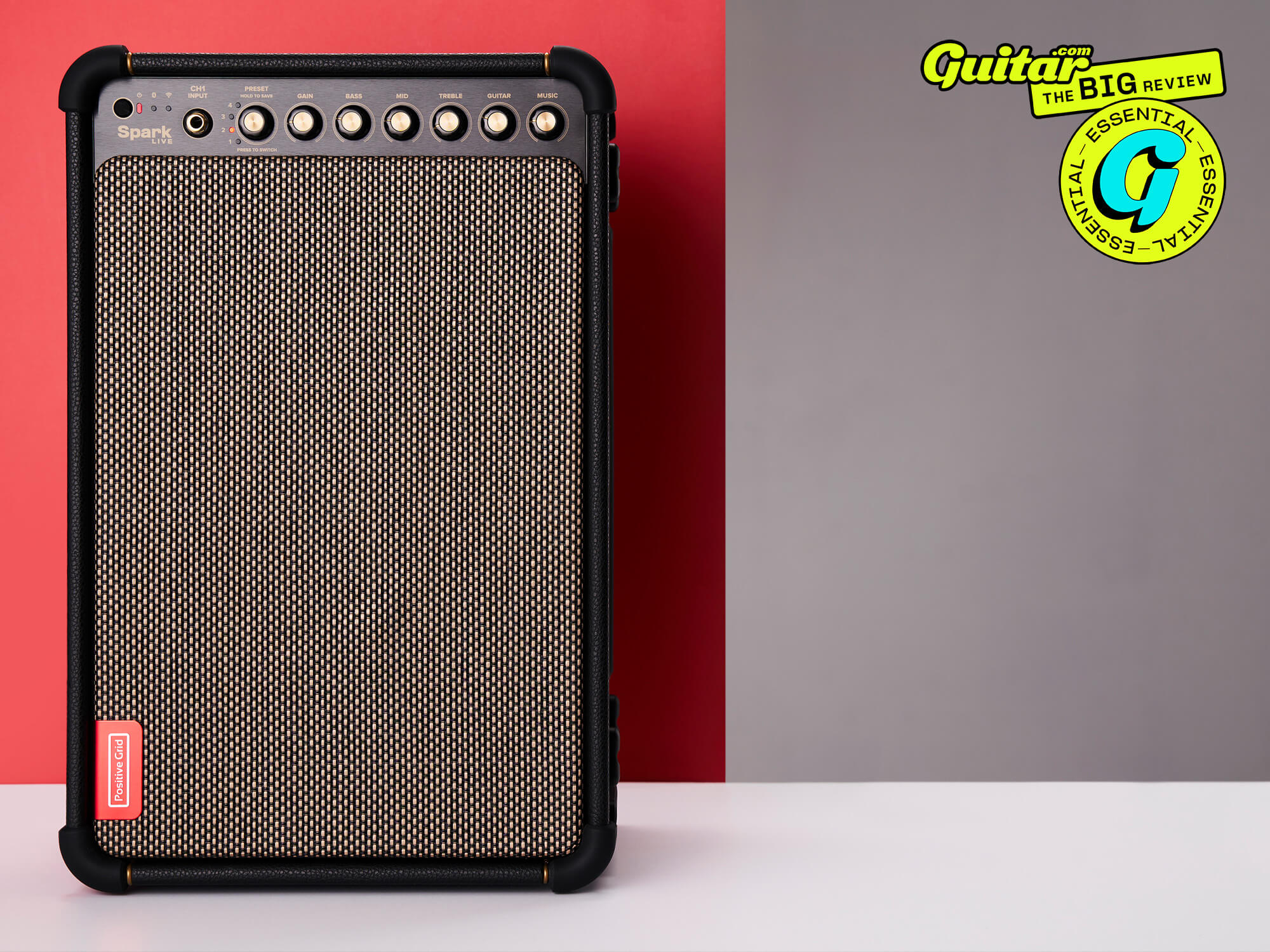 Positive Grid Spark Live. Image: Adam Gasson
Positive Grid Spark Live. Image: Adam Gasson
[products ids=”56O4XNZQn8feYt4u8LcT3p”]
Not content with making an excellent small, low-volume home amplifier in the form of the Spark Mini, Positive Grid also wanted to create an equally innovative live tool. The Spark Live, rather than just being a larger Spark, is for all intents and purposes an entire live backline crammed into one compact enclosure.
It leverages the same smart tech that makes the Spark so easy to use, plus a few new bells and whistles, to cram a guitar amp, a bass amp and vocal processor all into the same enclosure, effectively a superpowered FRFR speaker that can easily support a small band. All very cool – even cooler is the fact that the rechargeable battery (sold separately) promises eight hours of performance time: absolutely perfect for busking.
Need more? Read our Positive Grid Spark Live review.
Best beginner’s amp: Blackstar Debut 50R
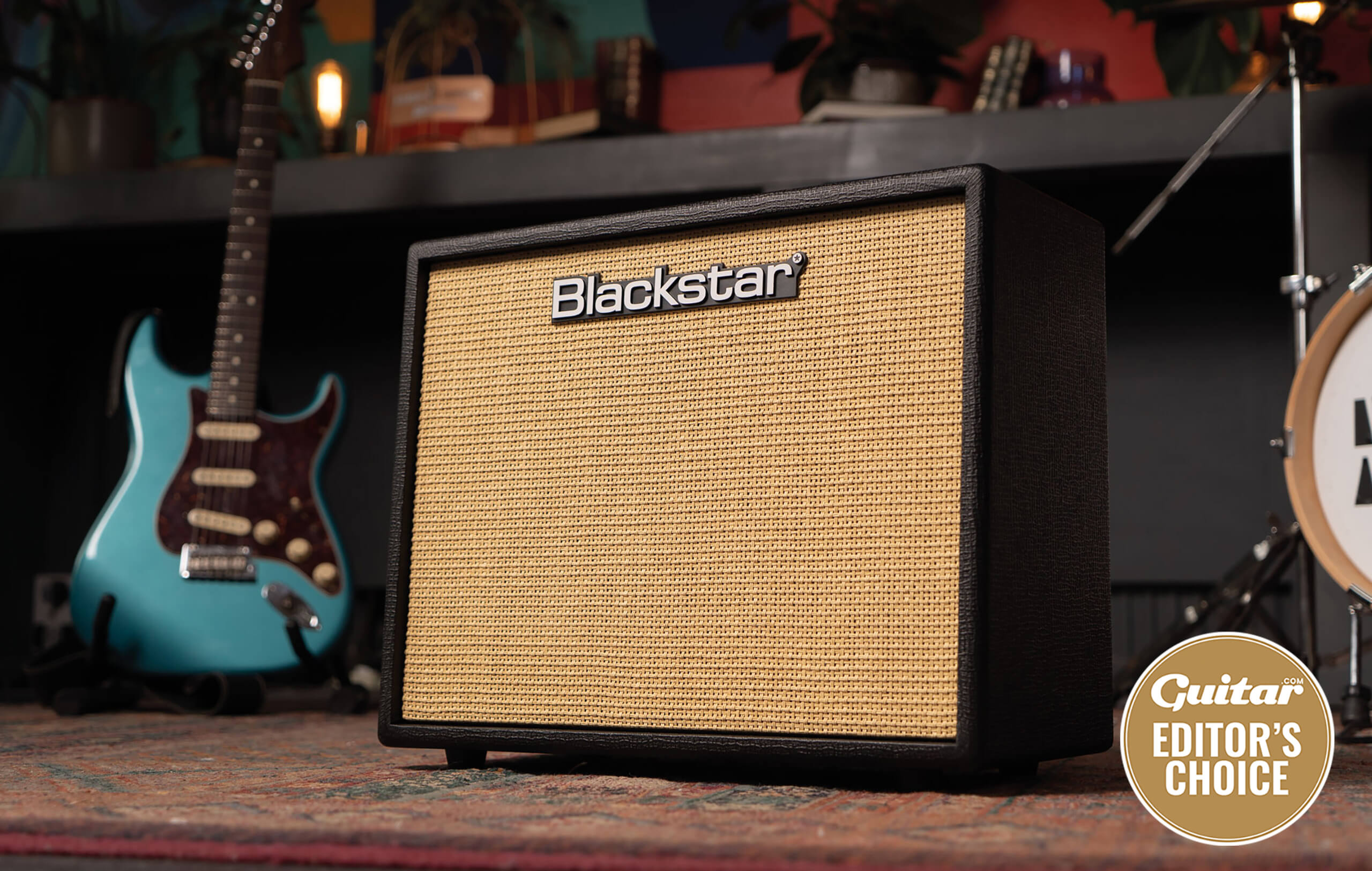
[products ids=”4eIZyJgJOkfDfe5xy46y6T”]
What makes the Blackstar Debut 50R such an appealing prospect for absolute beginners is this: it’s simple. Not including a smorgasbord of digitally-modelled sounds on an amp aimed at absolute beginners is, for our money, a smart choice – as it’s all analogue, what you see is what you get.You’re already busy getting your head around an F barre chord – you don’t need the extra cognitive load of trying to remember how the preset recall button works. Instead, the Debut 50R does a great job of just letting you play the guitar.
That’s not to say it’s a totally stripped-back, old-school affair – there is a line-in for playing along to tracks, a fairly decent headphone out for direct recording and silent practice, a power-reduction mode for quietening things down. And when you’re ready to move from a bedroom to a stage, the Debut 50R can come with you. The 50-watt power section will be more than happy to keep up with a drummer. The rest is up to you!
Need more? Read our Blackstar Debut 50R review.
Best metal amp: Victory The Kraken MKII
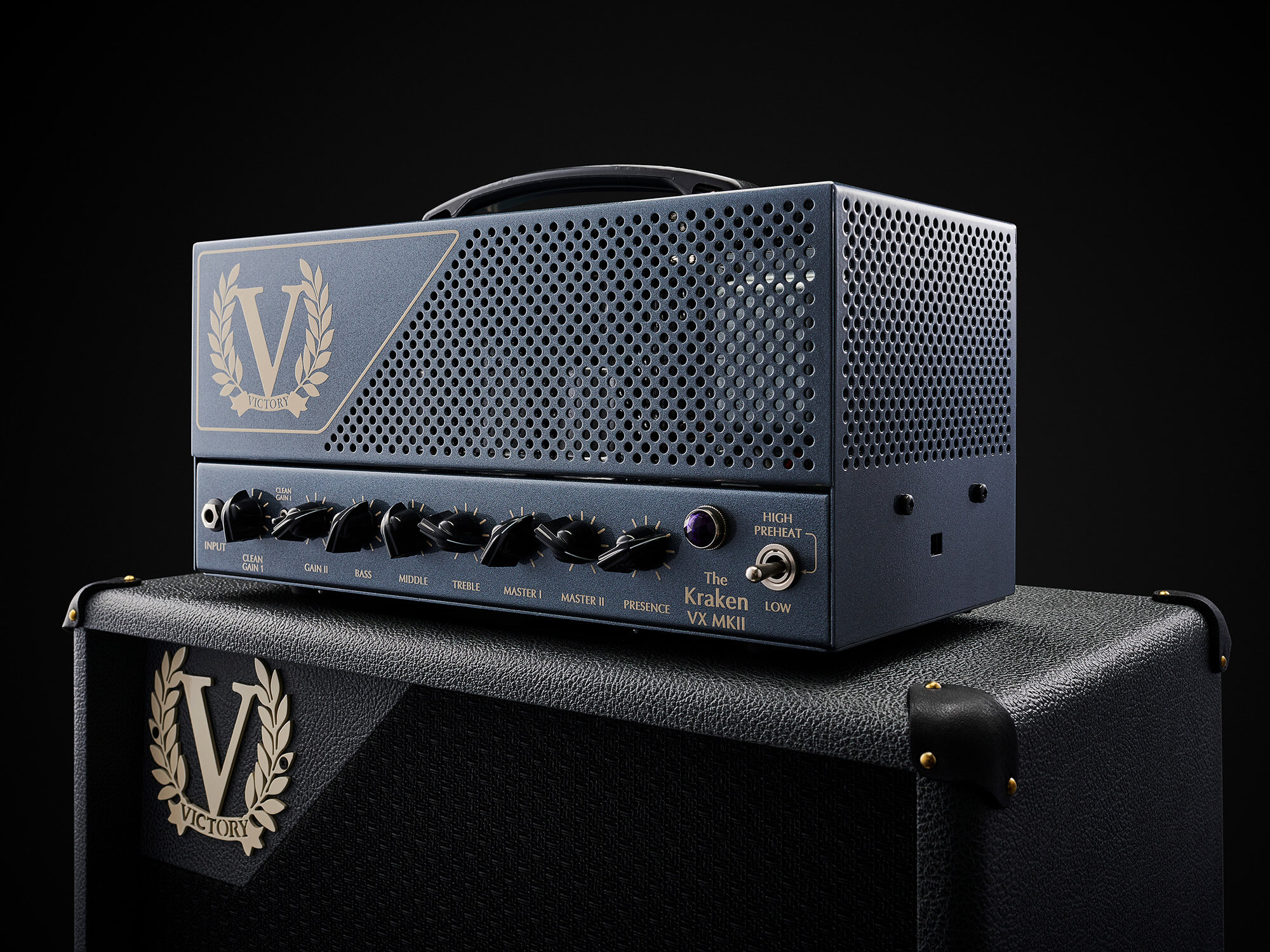 Image: Victory Amplification
Image: Victory Amplification
[products ids=”72MogFZ0vwHKMXhIUN1okP”]
The latest update to the Kraken, Victory Amplification’s flagship metal monster, refines an already great amp into an absolutely fantastic one. As well as an overall refine of the sound, major circuit additions come in the form of a new presence control – good for adding some cutting bite to things – and to a brand-new clean channel, acheived by attenuating the lower-gain, JCM800-based Gain I channel for a spongey, responsive clean sound woth bags of character. But, of course, the main appeal is the Gain II channel – a fire-breathing take on a modded 5150-style circuit.
The result is a near-perfect metal sound: plenty of crunch, more than enough gain, and it can be as aggressive as you like or as compressed as you like. That pretty much covers the metal guitar tonal palette, and the excellent performance at the other end of the gain scale makes this a very versatile offering indeed. Or, you know, good for that 10-second clean intro before 50 minutes of riffs.
Need more? Read our Victory The Kraken MKII review.
Why You Can Trust Us
Every year, Guitar.com reviews a huge variety of new products – from the biggest launches to cool boutique effects – and our expert guitar reviewers have decades of collective experience, having played everything from Gibson ’59 Les Pauls to the cheapest Squiers.
That means that when you click on a Guitar.com buyer’s guide you’re getting the benefit of all that experience to help you make the best buying decision for you.What’s more, every guide written on Guitar.com was put together by a guitar obsessive just like you. You can trust that every product recommended to you in those guides is something that we’d be happy to have in our own rigs.
The post The 14 best amplifiers for all styles and budgets appeared first on Guitar.com | All Things Guitar.
Death of Ace Frehley under investigation

An investigation into the death of KISS guitarist Ace Frehley has been launched.
The veteran musician died in Morristown, New Jersey on October 16 at the age of 74. A statement shared by Frehley’s family confirmed the guitarist – also known as Spaceman – died “peacefully surrounded by family” following “a recent fall at his home”.
Medical examiners in New Jersey confirmed they would be opening an investigation into the death. Frehley’s cause of death will be finalised in the next few weeks pending a toxicology report, according to a Morris County Medical Examiner who spoke to TMZ.
The medical examiner added that, while no autopsy was done, external examinations and a toxicology report are currently being carried out.
 Credit: Gary Miller/Getty Images
Credit: Gary Miller/Getty Images
A statement from Frehley’s family, released at the time of his death, reads: “We are completely devastated and heartbroken. In his last moments, we were fortunate enough to have been able to surround him with loving, caring, peaceful words, thoughts, prayers and intentions as he left this earth.
“We cherish all of his finest memories, his laughter, and celebrate his strengths and kindness that he bestowed upon others. The magnitude of his passing is of epic proportions, and beyond comprehension. Reflecting on all of his incredible life achievements, Ace’s memory will continue to live on forever!”
Tributes were also made in an official statement from Kiss. A post to the band’s social media hailed Frehley as a crucial part of the group’s history.
Kiss’s tribute read: “We are devastated by the passing of Ace Frehley. He was an essential and irreplaceable rock soldier during some of the most formative foundational chapters of the band and its history.
“He is and will always be a part of Kiss’s legacy. Our thoughts are with Jeanette, Monique and all those who loved him, including our fans around the world.”
Frehley would found Kiss in 1973 alongside singer Paul Stanley, bassist Gene Simmons and drummer Peter Criss. He left the band a decade later to pursue a solo career but rejoined the group in 1996. Frehley would leave again in 2002, and did not rejoin the band for their 2022 farewell tour.
Further tributes were made by Rage Against the Machine guitarist Tom Morello and progressive metal band Opeth. Ex-Kiss member Bruce Kulick also hailed Frehley as an “iconic guitar player” who had an “undeniable role in the creation and success of Kiss”.
The legendary guitarist, who once said he was an “anomaly” of a musician [via The Guardian], would help Kiss write hits like I Was Made for Lovin’ You, Detroit Rock City, and Love Gun. Frehley would also achieve success as a solo artist. He released his final album, 10,000 Volts, in 2024. It peaked at 72 on the US Billboard 200 chart.
The post Death of Ace Frehley under investigation appeared first on Guitar.com | All Things Guitar.
Podcast 522: Raymond Morin of Acoustic Music Works
Raymond Morin of Pittsburgh’s Acoustic Music Works joins us this week for an insightful chat about running a guitar store, music and so much more.
At a time when things seem pretty bleak for mom & pop guitar stores, Pittsburgh’s Acoustic Music Works is a true success story. They just moved to a new, larger location with a focus on a handful of higher-end brands and the occasional in-house concert.
https://acousticmusicworks.com
We talk about Raymond pivoting career-wise into the world of guitars; the guitar-building class he took before he became a salesperson; Collings and some of the other brands Acoustic Music Works carries; and Raymond’s own Pleinview line of instruments.
Our new, 57th issue of the Fretboard Journal is now mailing. Subscribe here to get it.
Our next Fretboard Summit takes place August 20-22, 2026, at the Old Town School of Folk Music in Chicago. https://fretboardsummit.org
We are brought to you by Peghead Nation: https://www.pegheadnation.com (Get your first month free or $20 off any annual subscription with the promo code FRETBOARD at checkout).
The post Podcast 522: Raymond Morin of Acoustic Music Works first appeared on Fretboard Journal.
Gretsch CVT review: a cult classic reborn as a stripped down rock machine

$419/£499, gretschguitars.com
As this week’s cover story explained in more detail than I’ve got room to go into here, the Gretsch Corvette is something of a unique proposition in the world of electric guitars. Here we have a solidbody electric design that was created during the Golden Era of American electric guitar manufacturing, by one of the most beloved and famous brands of that time that hasn’t been done to death.
Let that sink in – despite the Corvette having found its way into the hands of literal icons like Jimi Hendrix and Rory Gallagher, this is a guitar that’s still under the radar. We live in a time guitarists are so desperate for the big brands to offer them something – anything – outside of the same half a dozen shapes that we’re seeing 70s landfill like the RD Artist and Starcaster get revived to huge fanfare.
Which is all to say it’s remarkable it’s taken Gretsch so long to get here. It’s been nearly 20 years since Gretsch first added an Electromatic Corvette into the line-up, and half a decade since it was discontinued. In that time, however, we’ve seen multiple signature models that speak to the design’s enduring appeal and outsider chic – for Fall Out Boy’s Patrick Stump, guitar-toting rapper G. Love and most importantly Bleachers frontman and Taylor Swift mega-producer Jack Antonoff.
That guitar – technically branded a Princess, the Corvette’s short-lived little sister – is perhaps the most important piece in that puzzle. When that guitar dropped last year, people promptly lost their collective shit – as did I, frankly – and I don’t doubt that the resounding reception that guitar was given has fed into the revival of the Corvette into the line proper, albeit with a new name: the CVT.
 Image: Adam Gasson
Image: Adam Gasson
Gretsch CVT – what is it?
Pithily, it’s a Corvette without the vowels, innit? But on closer inspection there’s actually a fair bit here that explains why Gretsch felt the need to give it a new name altogether. For starters, when you put a classic Corvette next to the CVT, you’ll notice that the body has been subtly tweaked for reasons of both form and function.
Most notably the body is about a centimetre thicker than the original, while the carve on the sides has been lessened – you don’t get those SG-like edges here. The top horn has also been made a little stubbier than the original design, which makes the guitar look a little more stocky and aggressive – personally I think it’s a bit of a glow up, but your mileage may vary.
And there are more big changes outside of the cosmetic stuff. Most notably, the CVT is a bolt-on design rather than a set-neck – something that Gretsch says was done to take some of the low-end fuzziness out of the guitar’s all-mahogany build. The scale length is the same 24.6 inches as all the Gretsch Jets – so it’ll feel a little more compact than a Gibson but not really noticeably so. The headstock has also been tweaked – swapping the paddle-like original for a pointy ‘Falcon’-style option. The best compliment you can give it is that you’ll instantly assume it’s always been like that, as the shape compliments the body’s lines much more naturally.
Elsewhere you’ll find a pair of Gretsch’s Twin Six humbuckers and a no-fuss intonatable wrapover tune-o-matic-style bridge. As someone who absolutely loves Filter’Trons, I always think it’s a shame when Gretsch puts more generic humbucking pickups in its affordable guitars, but given the CVT’s hard-rocking target market, it probably makes sense. The humbuckers eschew any Gretsch switching eccentricity in favour of a simple three-way toggle with shared volume and tone controls.
 Image: Adam Gasson
Image: Adam Gasson
Gretsch CVT – build quality and playability
Even if you weren’t aware of the changes to the CVT’s body depth, you’d probably notice it when you heaved the guitar out of its box. This is no Les Paul in terms of its weight, but my example tipped the scales at very nearly 8lbs. Now, for most people, that’s perfectly acceptable, and you probably wouldn’t have a sore shoulder after gigging this all night. However, it was still heavier than I expected, and heavier than it looks like it should be – something that’s exacerbated somewhat by a lot of that weight seemingly focused on the bottom of the guitar. It’s not enough to make it feel unbalanced, but I still felt a pull to that end more than I’d like on the strap. It’s probably not helped by the baffling choice to stick the top strap button under the horn – just put it on the back!
That asides though, you really do have to remind yourself that this guitar barely costs $400. The build, fit and finish is absolutely flawless all over – I couldn’t find a single mark, rough edge, oversprayed finish or untidy assembly anywhere, and removing the scratchplate reveals a very tidy and unfussy wiring job too.
The neck profile is what Gretsch calls a ‘Performance C’ and it’s very comfortable if a tad generic. It won’t please the baseball bat aficionados, but it strikes a nice balance between giving you something to grip onto when you’re chugging away at the bottom end, without compromising the performance when you want to get a bit widdly up top. Speaking of which, the carve on the heel, while not removing the inherent chonk of a bolt-on arrangement, definitely makes those upper-fret excursions more comfortable than it would be otherwise. With very little to go wrong here, it’s perhaps no surprise that the tuning stability is rock solid, but you should never take it for granted – many a great guitar has been hampered fatally by an inability to stay in tune, and given this guitar’s rock-oriented persuasion, it needs to be able to take some heavy handed punishment and stay the course.
 Image: Adam Gasson
Image: Adam Gasson
Gretsch CVT – sounds
Unplugged resonance is always a great bellwether of an electric guitar’s overall performance, and again things are really encouraging here – it’s bright, snappy and lively. There is some minor string buzz on the D string when played open, but it’s probably a price worth paying for an action that is low and slinky.
In addition to its famous signature adherents, Gretsch is clearly aware of the brand’s growing popularity with artists at the heavier end of the spectrum and it’s hard not to see the CVT as a direct response to that.
That’s certainly the case when you plug in – these Twin Six humbuckers are pokey, to say the least. They will snarl with almost any encouragement and positively lap up gain – be that smooth overdrive, glitchy fuzz or indeed heavier slabs of crushing distortion. What’s really impressive is that they don’t ever get muddy or wooly with this – the extra midrange bump offered by that bolt-on is clearly doing its job here.
The bridge pickup is a riff monster, with power and clarity that makes short work of heavy chugs, arpeggiated chords and rapid powerchords. The neck pickup has that chewy, thick quality that a mahogany solidbody neck humbucker should have – adding some delay and reverb to a driven tone offers impressive sustain and clarity, again without ever getting too dark and messy.
You’ll notice I started talking about the gained-up sounds out of the gate and there’s a reason for that. When you’re dealing with a sub-$500 twin-humbucker solidbody, you know it’s likely to not be the most inspirational instrument for cleans, and so it is here. These aren’t bad sounds – there’s still that clarity and midrange punch to make them perfectly usable, especially if you’re running it into some good reverb and delay pedals – but there’s a definite lack of character to the unvarnished tonality.
 Image: Adam Gasson
Image: Adam Gasson
Gretsch CVT – should I buy one?
The most exciting thing about the budget end of the guitar market in recent years is how interesting and diverse it has become – gone are the days where if you wanted something with a pair of humbuckers in it for under $500, your choices were Les Paul, SG or maybe something pointy.
The CVT slides into this market with a confidence and focus that befits a design that has technically been around almost as long as some of the icons that its rubbing shoulders with here. It’s easy in the guitar world to naturally equate old with good, but there’s something authentic and classic about the Corvette shape, modified though it is here, that gives the CVT an extra bit of kudos and credibility.
It looks good, plays good and – provided you’re not buying it purely for the clean sounds – it sounds great, too. A new heavyweight contender in the budget rock guitar world has arrived.
Gretsch CVT – alternatives
If you want a Gretsch guitar that sounds a bit more, well, Gretsch-y then the G5220 Electromatic Jet ($579) sports more classic Broad’Tron pickups. If you want an affordable hard-rockin’ electric that’s a little more lightweight, Epiphone SG Standard ($599) is lot of guitar for the money – it’s not hard to imagine that the SG was on the mood board when Gretsch was designing the original Corvette too. Yamaha’s Revstar Element ($599) is another twin-bucker double-cut solidbody that stands out from the crowd – they’re killer guitars for the money too.
The post Gretsch CVT review: a cult classic reborn as a stripped down rock machine appeared first on Guitar.com | All Things Guitar.
Taylor Guitars Expands Popular SOMOS Collection with Six New Models
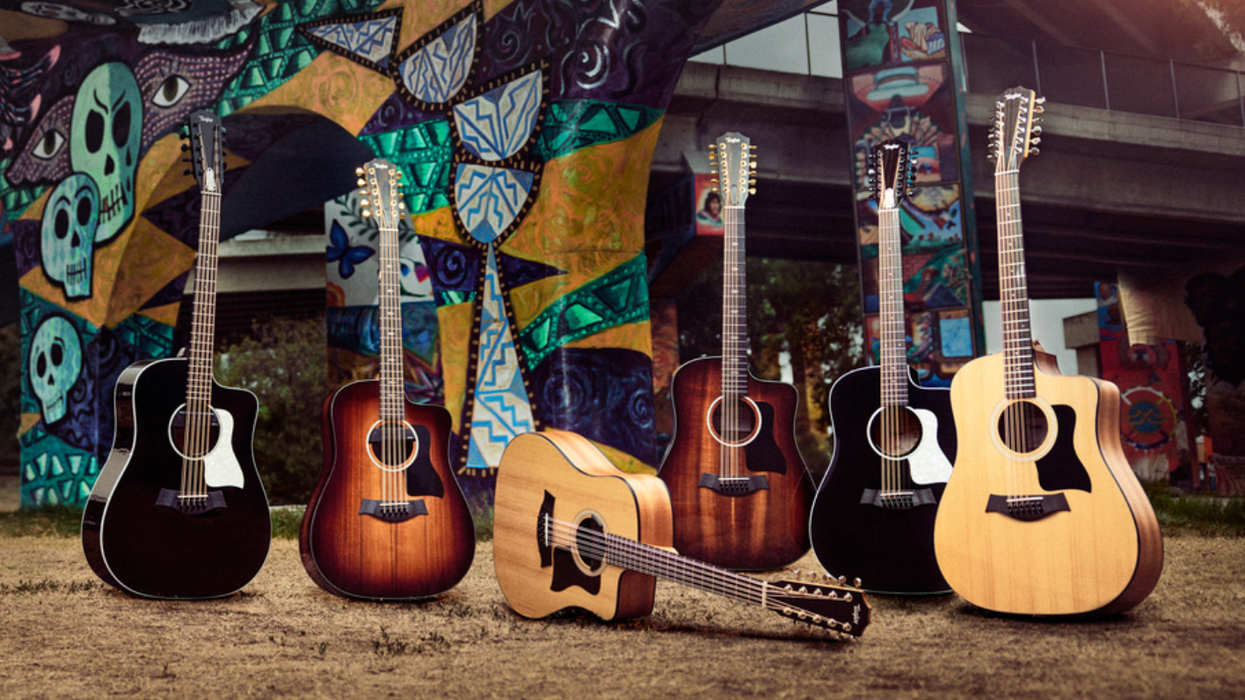
Taylor Guitars, the leading global builder of premium acoustic guitars, today announced a major expansion of its SOMOS Collection®, adding six new double-course models designed for Latin music styles and broader sonic exploration. The release includes three new Bajo Quinto (10-string) and three Doce Doble (12-string) guitars across the 100 Series, 200 Plus Series, and 200 Deluxe Series, making the collection more accessible to a wider range of players. All six models are available now at authorized Taylor dealers worldwide and on TaylorGuitars.com.
“With the SOMOS Collection, we’re celebrating our musical and cultural connections that define our home in Southern California and Baja California,” said Andy Powers, Chief Guitar Designer and CEO at Taylor Guitars. “These new Bajo Quinto and Doce Doble models support the growing demand for instrument innovation and quality in Latin American music, bringing new textures and tonal possibilities to guitarists worldwide.”
Latin-Inspired Sound and Style
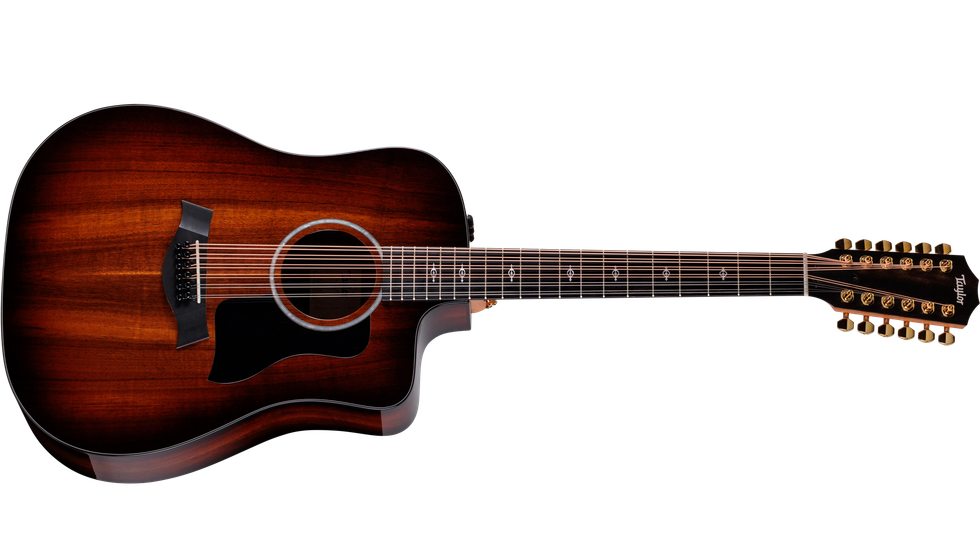
The SOMOS Collection® was first introduced as a family of Latin-inspired acoustic instruments that reflect Taylor’s Southern California roots and the diversity of its musical community. “Somos,” meaning “we are” in Spanish, evokes unity, identity, and shared expression.
Each new model features a cutaway Dreadnought body, onboard electronics, a slim, easy-playing Taylor neck, and C-Class bracing, a variant of the company’s patented V-Class® bracing, engineered to enhance volume, sustain, and intonation. D’Addario custom string sets for their respective tunings, and an offset bridge-pin and string-ramp setup that boosts the resonance and responsiveness without the string interference typical of traditional 10- or 12-string designs.
Model Highlights
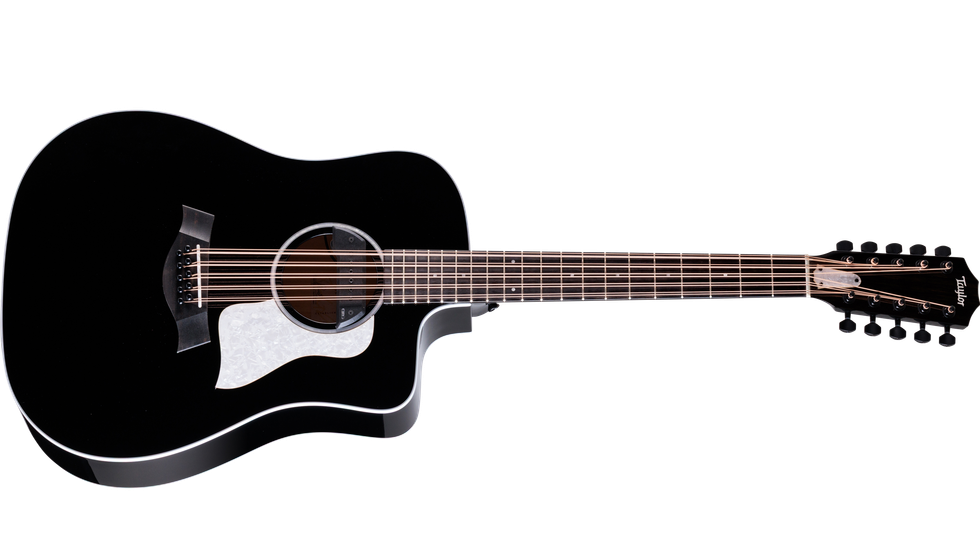
100 Series – 150ce Bajo Quinto / 150ce Doce Doble
The most price-friendly entries in the SOMOS Collection, the 100 Series models channel a clean, traditional aesthetic with a natural matte finish, black binding, dot inlays, and chrome tuners. Torrefied spruce tops paired with layered sapele backs and sides deliver warm, classic tone with powerful punch and articulation. Includes gig bag and either EMG ACS soundhole humbucker pickup (Bajo Quinto) or Taylor’s ES2 electronics (Doce Doble). Starting at $899 USD.
200 Plus Series – 250ce Plus BLK Bajo Quinto / 250ce Plus BLK Doce Doble
Boasting bold blacktop finishes, white binding, and Italian acrylic accents, these models make a stark visual statement perfect for any performer. Layered maple back and sides add brightness and projection, complemented by a solid torrefied spruce top for balance and volume. Outfitted with AeroCase protection and a choice of EMG ACS pickup (Bajo Quinto) or ES2 electronics (Doce Doble). Starting at $1,599 USD.
200 Deluxe Series – 260ce-K DLX Bajo Quinto / 260ce-K DLX Doce Doble
Crafted with figured, layered Hawaiian koa back and sides and a solid koa top, these guitars combine a bold, shimmering tone with showstopping visuals. A gloss shaded edgeburst finish, gold tuners, and Sentinel fretboard inlays make these guitars destined for the stage. Each includes a Taylor Deluxe Hardshell Case, and EMG ACS or ES2 electronics. Starting at $2,099 USD.
A Modern Take on Tradition
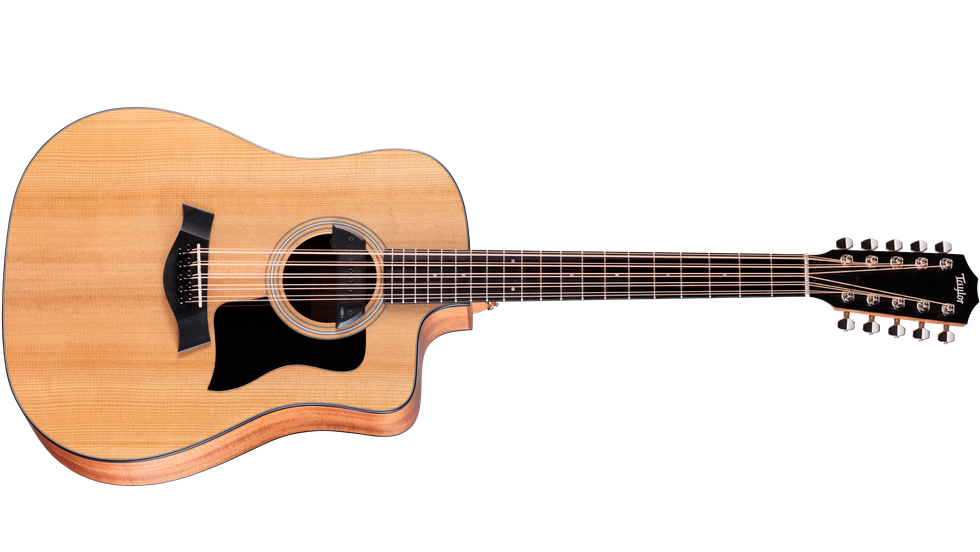
The requinto-style Doce Doble reimagines the unison-strung 12-string format long favored in regional Mexican and Latin music, producing lush, chorus-like textures suited for any genre. The Bajo Quinto, a mainstay in Norteño and Tejano ensembles, offers five double courses tuned in fourths (A-D-G-C-F), creating a bold, rhythmic foundation that complements both bass and accordion accompaniment.
The new SOMOS Collection instruments are already being played by leading artists and producers shaping the sound of contemporary regional music, including Angel Aispuro and Edgar Rodriguez; Juan Bojorquez (“El Pony”) of Fuerza Regida; Carlos Torres with Peso Pluma; Jorge Tapia with Natanael Cano; Joaquin Ruiz of Grupo Firme; Alan Nieblas from Alta Consigna; and Gil Leyva with Junior H.
“For me, the Taylor bajo quinto and doce doble have really helped me find new ways to express myself,” said Joaquin Ruiz, guitarist for Grupo Firme. “They’ve inspired me with their fresh sound and unique approach. Just like music evolves, there’s a real need for instruments to keep up with that change.”
Crafted Across Borders
The new SOMOS Collection models are built in the company’s state-of-the-art Tecate, Baja California, Mexico manufacturing facility, just across the border from its El Cajon, California headquarters. The Tecate plant, which has produced Taylor’s 100 and 200 Series guitars for decades, plays a central role in the company’s focus on craftsmanship, sustainability, and broader access to the highest-quality instruments.
“The SOMOS Collection is literally and spiritually built on both sides of the border,” Powers added. “It’s a reflection of who we are – ‘somos’ – as makers, musicians, and neighbors.”
The six new SOMOS Collection models are avao;ab;e starting at $999 USD street price (150ce) and ranging up to $1,699 USD (260ce-K DLX).
For more information about the Somos Collection, visit TaylorGuitars.com/Somos.
Keeley Oaxa Dual Stereo Phaser Demo | First Look
Double dip in the modulation whip with Keeley's new twin phaser.
Most effects modify the amplitude of the signal like a distortion or compressor pedal. Others modify the timing of signals like delay and reverb. Guitar phasing is achieved by blending your original signal with a frequency domain altered version of the signal. The frequency modified component can be thought of like an EQ pedal that is rhythmically adjusted. As a result, when the two signals are combined you get the instantly recognizable sound of a... phaser.
There's no better way to make your guitar sound spacey, psychedelic, or "liquid". Phasers and vibes have that instantly recognizable dreamy and other-worldly tone. The Oaxa Phaser gives you double the fun with two independent phasers. Two phasers with slightly different LFO speeds can lead to dramatic and inspiring multidimensional layers and textures. The Oaxa Phaser offers you ten stage, four stage, and uni-vibe phasing all with just three large vintage-style knobs. Alt features offer you a one-knob compressor and an additional low-end depth control. The dual phasers in Oaxa can be run in series or parallel. With true stereo processing and built on our award winning Core series platform, it's perfect for creative stereo effects loops. The Oaxa Phaser sounds so good you'll swear it's analog. It's ideal for creating swirling leads, atmospheric textures, or groovy and funky rhythms.
- Versatile Phasing Options: Switch between lush 10-stage, crisp 4-stage, or vintage uni-vibe modes with just three intuitive knobs for effortless control.
- True Stereo Power: Run dual phasers in series or parallel, perfect for pairing with stereo reverb and delay in your effects loop, creating expansive, studio-quality soundscapes.
- Enhanced Alt Features: A one-knob compressor and low-end depth control add warmth and punch, making every note sing.
- Analog Soul, Digital Precision: Built on our award-winning Core series platform, Oaxa delivers the rich, organic warmth of an analog phaser with modern reliability.
Stompboxtober 2025: Orange Amps

Enter now for your chance to WIN the Orange King Comp — a Class‑A VCA compressor pedal designed with pro‑level dynamics, dual attack/release controls, ultra‑low‑noise performance, and 18 V headroom for serious tone.
Stompboxtober 2025 - Win Pedals All Month Long!
Orange Amps King Comp Pedal
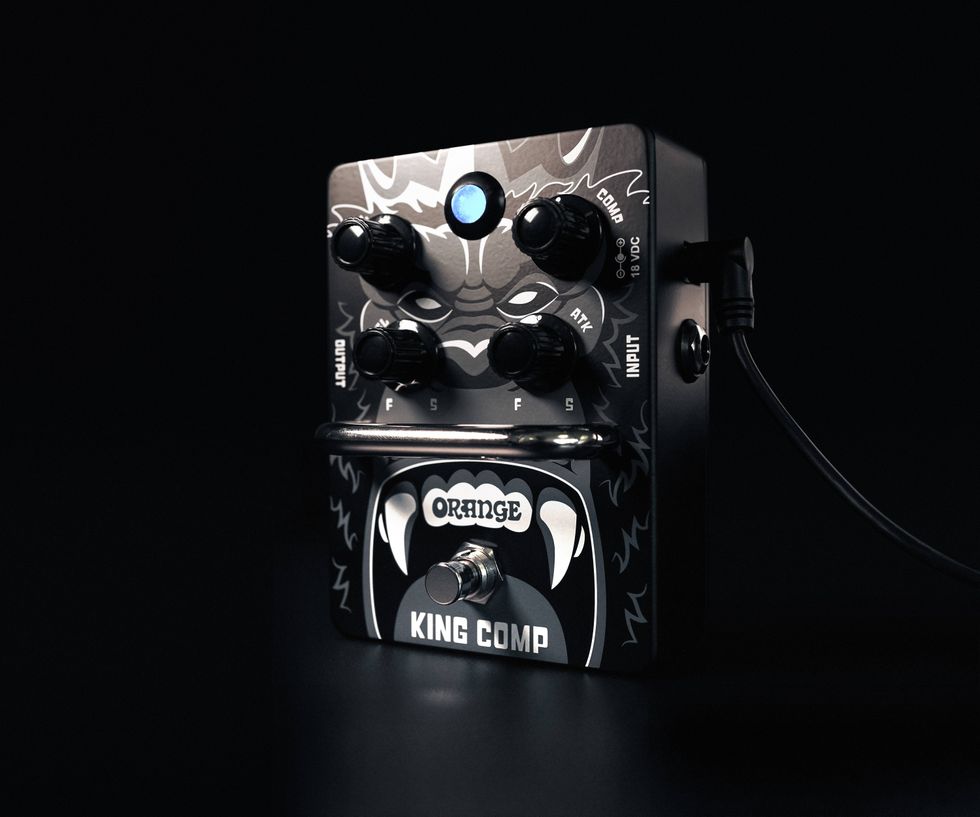
The King Comp is a super low-noise Class A VCA compressor pedal that brings studio-style dynamics to your pedalboard. From subtle squish to bold sustain, it enhances your tone with clarity and warmth without losing touch sensitivity. Use it to tighten your clean tone and smooth out single-note lines, whether you’re playing guitar or bass. The tweakable attack and release knobs allow you to shape your tone to perfection, meaning that whether you’re after subtle polish or full-on squash, the King Comp gives you precise dynamic control with a musical feel that responds like a great amp.

Orange King Comp VCA Compressor Pedal
Keeley Electronics Introduces Oaxa Phaser
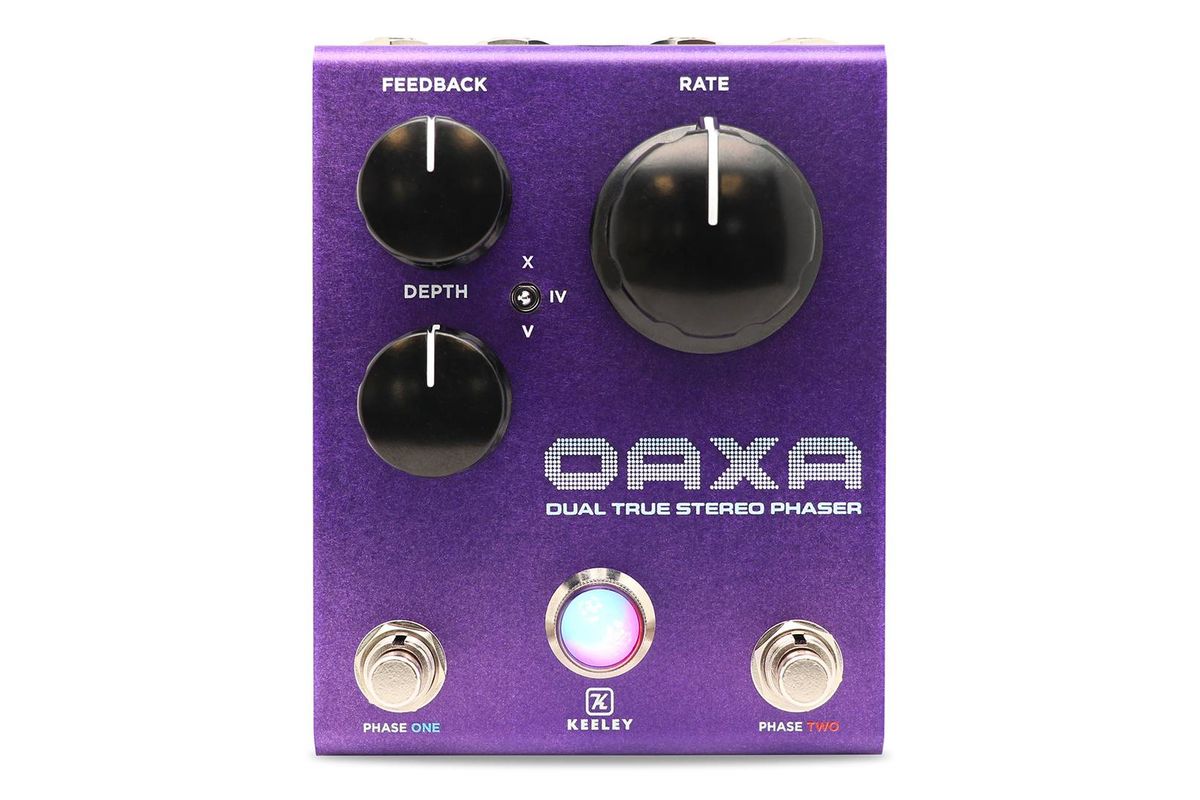
Keeley Electronics has launched the Oaxa Phaser, an advanced-yet-user-friendly pedal featuring two independent phasers, each controlled by a dedicated footswitch.
The Oaxa Phaser offers a three-position toggle for selecting 10-stage, 4-stage, and uni-vibe phasing, controlled with three easy-to-grab knobs. The dual phasers in Oaxa can be run in series or parallel, with true stereo processing. Built upon Keeley’s acclaimed Core series platform featuring large vintage-style knobs and pilot light, it’s perfect for creating swirling leads, atmospheric textures, or groovy and funky rhythms.
The Oaxa pedal’s Alt features offer even more sonic flexibility: in Alt mode you can access a one-knob compressor and an additional low-end depth control, and its Alt setting for the three-way toggle switch allows you to select 6-stage, 4-stage or 2-stage phasing.
Oaxa features include:
- Two independent phase circuits, each with its own footswitch
- Versatile Phasing Options: A three-position toggle switch allows you to select between lush 10-stage, crisp 4-stage, or vintage uni-vibe modes
- Alt setting for the three-way toggle allows you to select 6-stage, 4-stage or 2-stage phasing
- Simple and intuitive three-knob operation with Rate (controls the speed of the effect), Depth (controls the width of the phaser sweep) and Feedback (The amount of output added back to the input of the phaser, often referred to as “color”)
- True Stereo Power: Stereo inputs and outputs – you can run dual phasers in series or parallel, perfect for pairing with stereo reverb and delay in your effects loop
- Enhanced Alt Features: A one-knob compressor and low-end depth control add warmth and punch
- Selectable true bypass or buffered bypass modes
- Uses external power 9-18V - 130mA with standard center negative jack
- Built in the USA
Keeley’s Oaxa Phaser carries a street price of $199. For more information visit rkfx.com.
A range of Hello Kitty-branded Loog guitars just hit the market, but don’t worry – there’s a new full-sized White Hello Kitty Strat from Fender, too

Remember how we said Loog just partnered with Sanrio on a range of Hello Kitty-branded child-friendly guitars? Well, the Hello Kitty hype must be in full swing, as Fender has just expanded its own Hello Kitty Collection.
The lore behind Hello Kitty guitars is rich, but let me try to quickly clue you in: Fender first launched its Hello Kitty Strat back in 2006, notably to little reception.
However, after YouTuber TheDooo began uploading videos of himself playing the guitar in the late 2010s, searches for the six-string dramatically ticked upward, with average prices on Reverb rising 254% from $275 to $700.
Ever able to spot an opportunity in the market, Fender relaunched the Hello Kitty Strat last year, also coincidentally on Hello Kitty’s 50th-anniversary year.
Now, the Big F is keeping the Hello Kitty love alive, with a slew of new additions to its Hello Kitty Collection, not least a new white-finished Squier Stratocaster, priced at £439.99.
Beyond its white finish and unmistakable Hello Kitty decals across its body, the Fender Hello Kitty White Stratocaster boasts an easy-playing C-shape neck, contoured body, Fender humbucking pickup with volume control, and vintage-style tuning machines. A Deluxe Hello Kitty gig bag also comes included.
And if repping a Hello Kitty-branded Strat just wasn’t enough, the collection now includes a Hello Kitty fuzz pedal (£99.99), with an op amp-based circuit offering fuzz flavours from “overdrive-like grit to full-on ripping fuzz”.
There’s also a Hello Kitty pink and white woven guitar cable (£25.99), Hello Kitty White Poly Strap (£30.99), as well as two new T-shirt designs and a crewneck sweatshirt.
Learn more about Fender’s updated Hello Kitty Collection.
The post A range of Hello Kitty-branded Loog guitars just hit the market, but don’t worry – there’s a new full-sized White Hello Kitty Strat from Fender, too appeared first on Guitar.com | All Things Guitar.
Mr. Black Further Builds a Legacy of Innovation
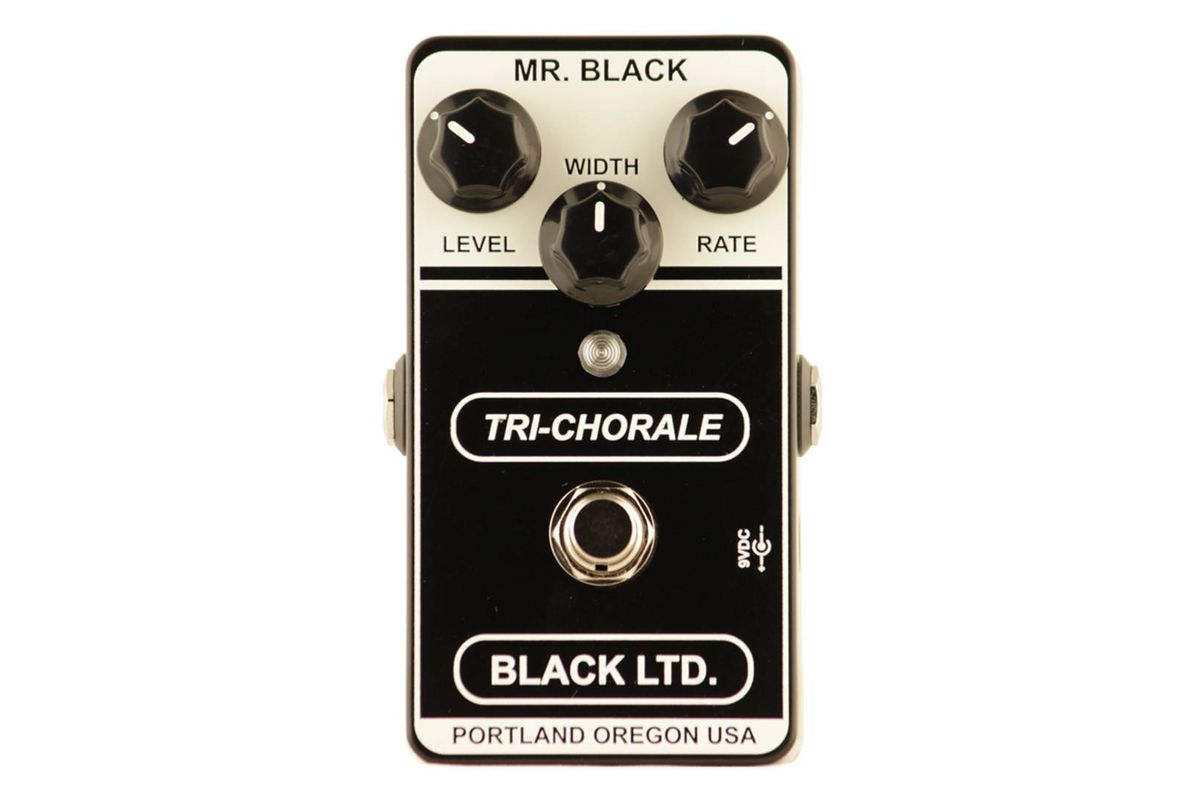
Building upon a legacy of sonic innovation, Mr. Black proudly unveils the Tri-Chorale – a lush, three-voice chorus inspired by the legendary Southern California designs of the mid-1980s.
At its core, the Tri-Chorale features three independent delay lines modulating in perfect harmony to create a rich, organic shimmer that feels alive under your fingers. Sharing a common LFO but offset in time and phase, these delay triplets breathe unprecedented depth and dimension into the classic chorus sound—elevating it to new, breathtaking territory. Sometimes, the sum is greater than its parts, and the Tri-Chorale proves it.
Key features:
- Three independent modulated delay lines
- Full, lossless wet/dry mix control
- Wide range of LFO speeds
- Pedalboard friendly footprint
- True-Bypass
- Powered by “Industry Standard” 9VDC
The Tri-Chorale carries a MAP of $199.95 and is handmade, one-at-a-time in Portland, Oregon U.S.A.
Available at: www.mrblackpedals.com and retailers worldwide.
These Hello Kitty-branded Loog guitars are the most adorable instruments of all time

Looking for the perfect gift for the budding guitarist in your life? Loog Guitars has teamed up with Sanrio on a new collection of kid-sized Hello Kitty guitars designed to help beginners pick up the guitar – and to make first riffs look ridiculously adorable.
The new Loog × Sanrio collaboration centres on a trio of compact, beginner-focused instruments: a mini three-string version of the cult favourite Hello Kitty Strat, complete with pickup and jack and two Loog Mini Acoustics in pink and white, each dressed in Hello Kitty artwork.
Every instrument also comes shipped with educational flashcards and access to Loog’s learning app, giving young learners everything they need to turn curiosity into actual chord progress.
“Cute, colourful, and totally beginner-friendly, these guitars are the ultimate first-instrument gift for kids ready to strum their very first songs!” says Loog.
The release follows Fender’s own Hello Kitty Stratocaster reissue last year, launched in celebration of the character’s 50th anniversary. That drop reignited the frenzy surrounding one of Fender’s most unexpected cult hits.
Originally introduced in 2006 as the Squier Hello Kitty Stratocaster, the model went largely under the radar at first, until YouTuber TheDooo began featuring it in viral Omegle jam videos in the late 2010s. According to Reverb, searches for the six-string skyrocketed, and resale prices followed suit, jumping from around $275 to an average of $700 – a 254 percent increase.
Fender’s 2024 relaunch offered two versions: the Squier Limited Edition Hello Kitty Stratocaster priced at $499, and the premium Made in Japan Fender Limited Edition Hello Kitty Stratocaster, exclusive to Tokyo’s flagship store and priced around $2,145.
Now, Loog’s partnership with Sanrio brings that same pop-culture energy to a younger audience, trading full-scale nostalgia for smaller frets and beginner-friendly fun. With the Hello Kitty craze alive and well, these new Loog guitars might just inspire the next generation of players (or collectors) one adorable riff at a time.
Learn more at Loog Guitars.
The post These Hello Kitty-branded Loog guitars are the most adorable instruments of all time appeared first on Guitar.com | All Things Guitar.
Mirador guitarist was worried Greta Van Fleet would think he was “defiling” Jake Kiszka by starting a band with him

Between Jake Kiszka and Ida Mae’s Chris Turpin, Mirador sounds like the guitar dream team you didn’t know you needed. But Turpin admits he was once worried fans might think he was “defiling” the Greta Van Fleet guitarist by starting the band with him.
The pair first crossed paths backstage in Detroit in 2018, when Ida Mae were opening for Greta Van Fleet. And now, with their self-titled debut album out last month, they’re reflecting on those first impressions in a chat with Classic Rock.
“Chris was this Zorro-like figure,” Kiszka says. “Like Strider sitting at the end of the bar. I was immediately struck by his playing. It was really incredible. And some of that earlier blues and folk stuff, it’s really rare to find players who can do that.”
Turpin, meanwhile, was equally impressed by Kiszka. “I’ve grown up with those hyper-classic guitar heroes; I loved Cream, Hendrix, Paul Kossoff from Free,” he explains. “And all of a sudden this… prick was there, going to the front, the guitar behind the head, and to these screaming people. I remember catching him topless backstage and being like: ‘Where the fuck have you guys been?! I’ve been waiting for a band like you for ten years!’”
Their first Mirador gigs only confirmed the chemistry. As Kiszka puts it, “it was like a nuclear reactor going off!”
“It’s incredibly exciting,” says the guitarist. “Because when you play in a band for years and years, there comes a point where the change in evolution becomes a bit more incremental. But what’s really exciting about this band is that everything is so fresh. Every single night is drastically different. There’s constant change, constant growth, constant communication.”
For Turpin though, that excitement came with its own set of anxieties.
“It was sink or swim,” he says. “Like: ‘Are these Greta fans gonna love this? Or are they gonna think I’m Beelzebub taking their precious baby away, breaking their hearts and defiling him?!’ But to see them get invested in it has been amazing. Tickets went so quickly. Mainly Jake fans. Ida Mae fans aren’t that quick off the mark. And there aren’t as many.’”
For now, despite ongoing commitments to their respective groups, the pair remain drawn to Mirador, describing the band as a creatively exciting project that will likely demand significant time and energy.
“This is such a time of creative excitement that I’m drawn to Mirador as often as I can,” Kiszka says. “It’ll be interesting to see what we develop as time goes on, and how we pace this thing.”
“Mirador feels like it’ll turn into this raging beast that’s going to take up a lot of time,” Turpin adds.
The post Mirador guitarist was worried Greta Van Fleet would think he was “defiling” Jake Kiszka by starting a band with him appeared first on Guitar.com | All Things Guitar.
“It’s a sine wave. Guitars are here to stay”: Warren Haynes says the cyclical nature of guitar music is normal

Warren Haynes says there’s no need to panic about the state of guitar music. The Gov’t Mule bandleader believes the instrument’s popularity comes in waves – and right now, it’s in a “pretty good place”.
Speaking on Andy Frasco’s World Saving Podcast, the Allman Brothers legend shares his thoughts on the supposed “death” of rock and the cyclical nature of public taste.
Asked if he thinks the guitar is dying, Haynes replies, “I think it, intermittently, kind of goes away for a while, and comes back. I kind of feel like it’s always going to come back. And I think we’re in a pretty good place right now. There’s a lot of good guitar music out there. It usually is about the music, or an artist, or band that comes along and kind of brings it back.”
Haynes adds that talk of rock’s demise has been around for decades, but history keeps proving the doubters wrong.
“People have been asking that question for decades,” he says. “I think going back to the early ‘90s, when people were saying rock ‘n’ roll was dead, and bands like The Black Crowes came along and proved that it wasn’t. So, yeah, I think it’s kind of a sine wave. People get tired of whatever it is they’re hearing, and something fresh comes along and kind of changes their palate for a while. But I feel like guitars are here to stay.”
Elsewhere in the chat, Haynes also names some of the newer acts he enjoys, noting that “there’s a bunch” even though he doesn’t ‘stay as on top of it as he probably should’.
“That band Robert Jon & the Wreck is cool. Of course, Marcus King is making a lot of headway, but I think there are a lot of young kids who are hearing like Derek Trucks playing open E, like this guy, Johnny Stachela, who plays with The Allman Betts Band. And there are a lot of people breathing new life into that these days.”
The guitarist also shouts out Dirty Honey for carrying the torch of old-school rock energy.
“This band, Dirty Honey, that I heard recently, it’s kind of a rock band in the traditional sense of the word,” says Haynes. “And I think it’s fun to see people [from] a generation that didn’t grow up here in all this music that we heard, and they’re discovering it for the first time and discovering bands that keep that music alive as well.”
“You know, it’s so odd because we get these young kids at Gov’t Mule shows occasionally, and they’re 14 and 15, and they’re just now discovering Gov’t Mule, but they’re also just now discovering Hendrix, and Led Zeppelin and Pink Floyd, you know, so and Warren and that.”
The post “It’s a sine wave. Guitars are here to stay”: Warren Haynes says the cyclical nature of guitar music is normal appeared first on Guitar.com | All Things Guitar.
Slayer announce new show for 2026 – after insisting they’re done for good

Less than a year after Kerry King swore that Slayer were finished for good, the thrash metal legends have announced a 2026 headline slot at the brand-new Sick New World Texas festival.
Set for 24 October, 2026, at the Texas Motor Speedway in Fort Worth, the inaugural edition of Sick New World Texas festival will celebrate the 40th anniversary of Slayer’s landmark album Reign In Blood. The stacked lineup also includes System of a Down, Deftones, Evanescence, The Prodigy, Marilyn Manson, Knocked Loose, AFI, Ministry, Mastodon, and Power Trip.
Fans can sign up now at SickNewWorldFest.com/Texas for presale access starting 24 October at 10AM CT, with remaining tickets available to the public later that day.
The announcement comes not long after Slayer’s string of high-profile reunion performances in 2025, including Louder Than Life in Louisville, Hersheypark Stadium in Pennsylvania, and Festival d’été de Québec, plus UK appearances at Cardiff’s Blackweir Fields and London’s Finsbury Park. The band, which officially disbanded in 2019, also played a six-song set at Black Sabbath’s Back To The Beginning farewell concert in Birmingham this July.
King, who now runs his own band and just last year released his first solo album From Hell I Rise, previously insisted that 2025 would be Slayer’s final run.
In an interview with Australia’s Metal Roos last December, the guitarist said that Slayer were officially done: “We’re never gonna make a record again. Mark my word: we’re never gonna make a record again, we’re never gonna tour again. Because that was the last thing. We said [back in 2018], ‘This is our final tour.’ It took five years for us to come and say, ‘Hey, here’s a couple of shows, five-year anniversary.’”
Fans might now be taking those words with a pinch of salt – or perhaps a full devil-horn salute. Either way, it looks like Slayer’s “final” chapter isn’t quite over yet.
The post Slayer announce new show for 2026 – after insisting they’re done for good appeared first on Guitar.com | All Things Guitar.
“I had an epiphany at IKEA!” This JHS pedal “annoyed” some builders because of how “fun” it was

JHS Pedals founder and self-confessed gear obsessive Josh Scott has opened up about the origins of the NOTAKLÖN – the DIY stompbox kit that blends the legendary Klon circuit with the simplicity of flat-pack furniture, all for under $100.
Speaking to Guitar World, Scott reveals how the do-it-yourself spirit of the Swedish furniture giant inspired the design of the modular overdrive pedal, which debuted in 2023.
“It came from me loving the Klon,” he says. “But there are so many good replications or clones of the circuit, and I wanted to do something unique. After several years of wrestling with that dynamic, I had an epiphany at an IKEA.”
That moment led him to think about what psychologists call the “IKEA Effect”: the idea that people value things more when they assemble them themselves.
“That’s a big piece of IKEA’s success,” says Scott. “And it felt like a really fun idea. I saw a product where parents who love the JHS brand could do something as a craft with their kids. That’s how we filmed the video and marketed the product.”
While there’s no shortage of Klon-style pedals or DIY kits on the market, Scott says the NOTAKLÖN stands out for its playful and approachable design.
“There are clones of the Klon circuit, even DIY kits, but there’s nothing as simple, modular, intuitive and almost Lego-like as the NOTAKLÖN,” he explains. “I don’t have vast ideas about changing or reshaping the market, but I do think it’s a truly innovative way to make a pedal.”
Not everyone, however, shared in the fun.
“It even irritated a few people,” Scott admits. “I saw a couple of other pedal builders who seemed to be annoyed by how toy-like and fun it was. And to me, that was the whole point. I wasn’t trying to change the world – I was trying to create a product that got parents to build something they love with their kids.”
Since then, JHS has followed up with the NOTADÜMBLË, released earlier this year. And while some might see the company as leading a new DIY pedal trend, Scott is quick to put things in perspective.
“There have always been DIY kits – JHS is not special in that,” he says. “[But] I do think that our product line is less intimidating and more satisfying to build for most customers. Not everybody wants to solder; not everybody feels like they can, and that’s okay. We give them a product they feel comfortable with. To me, that’s how it changes the game.”
The post “I had an epiphany at IKEA!” This JHS pedal “annoyed” some builders because of how “fun” it was appeared first on Guitar.com | All Things Guitar.


